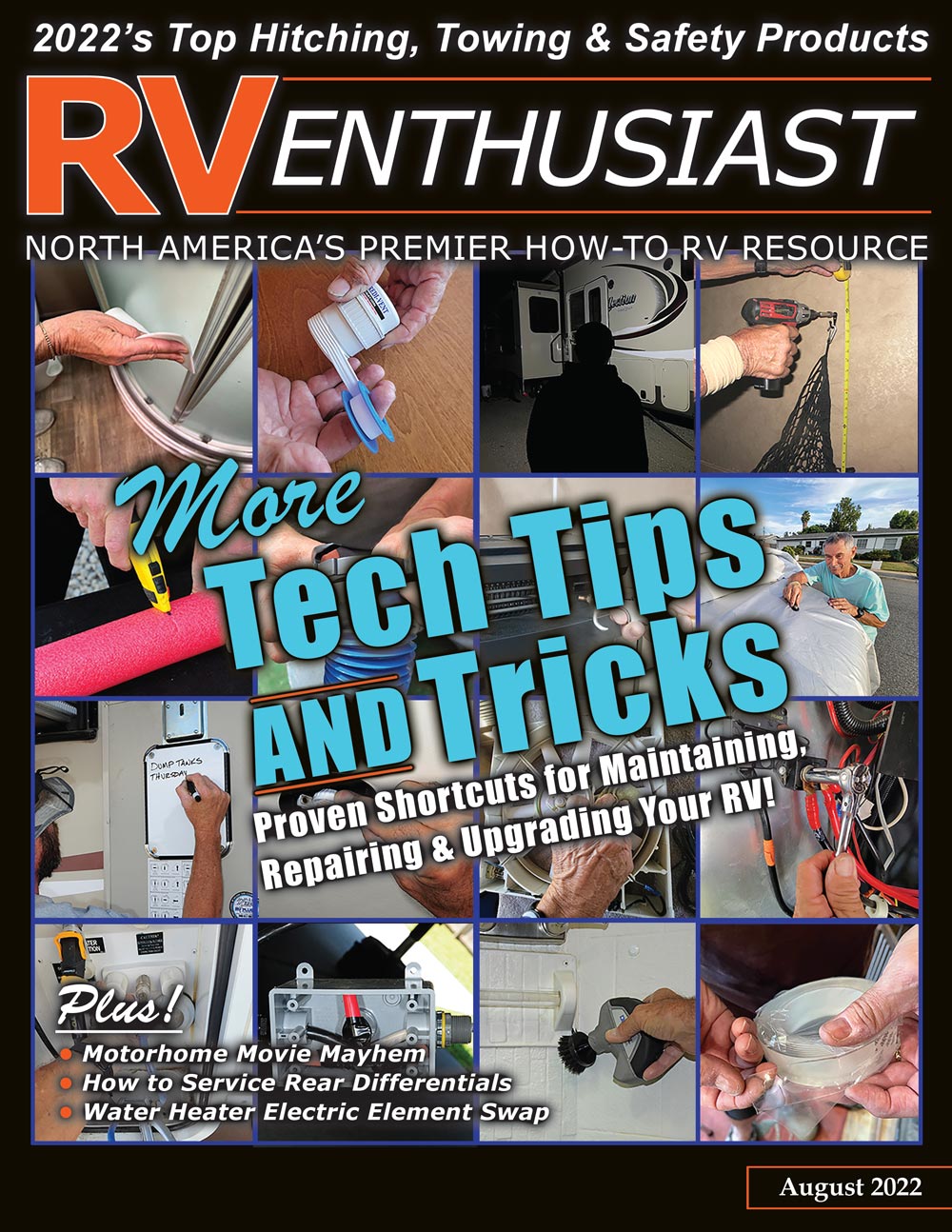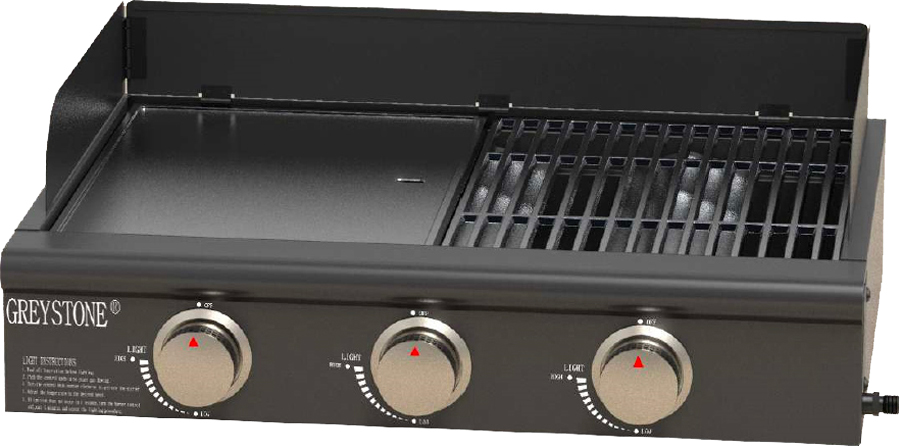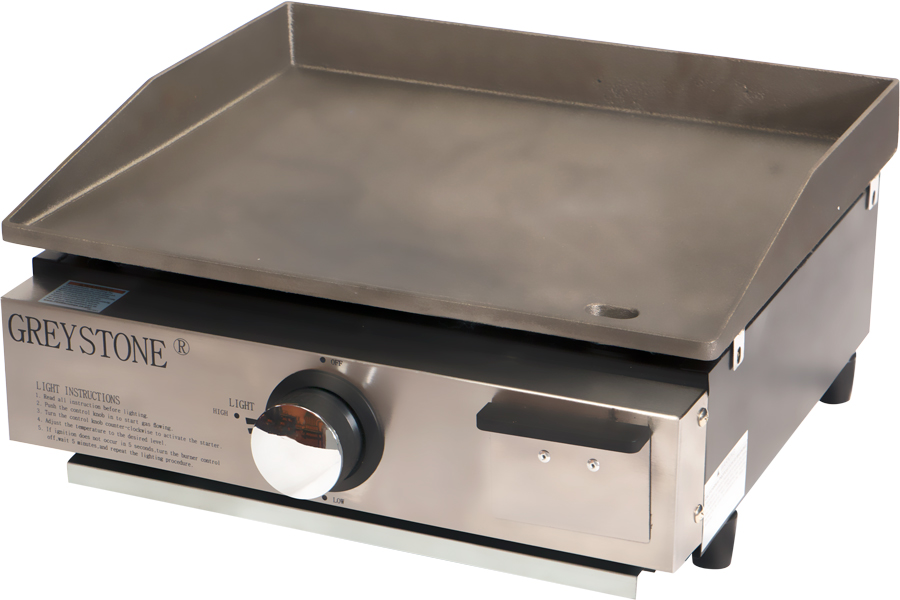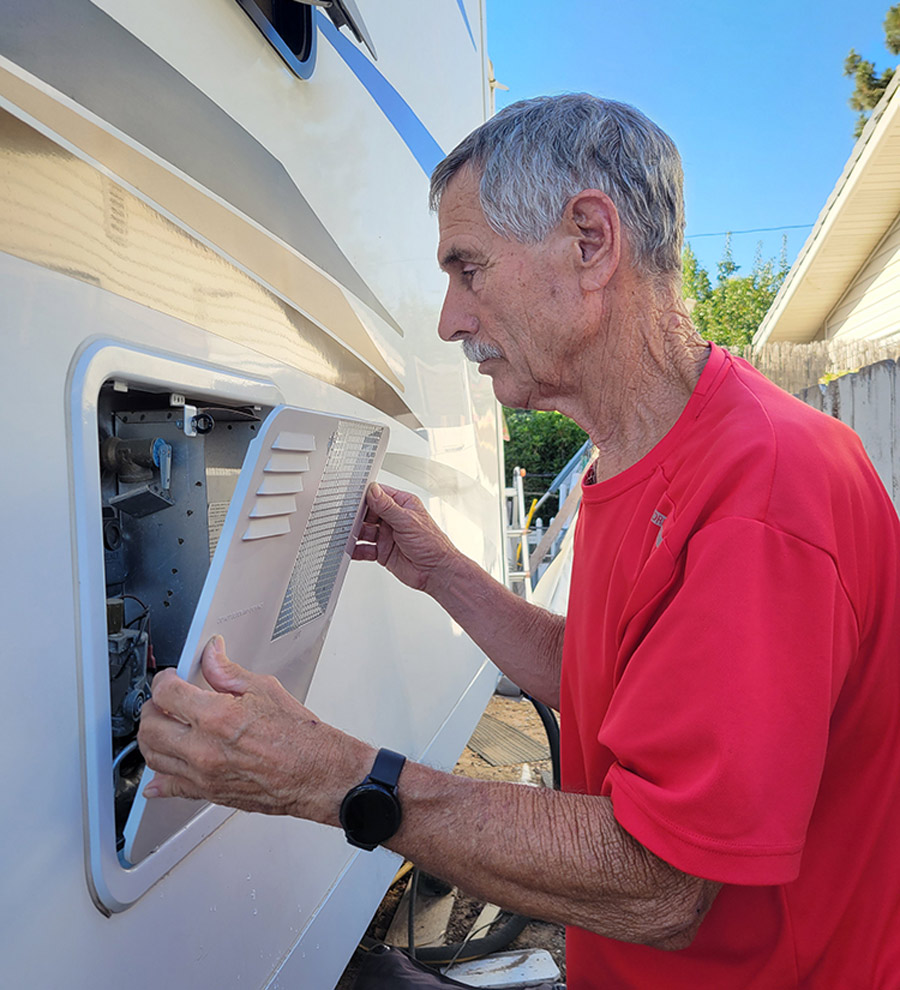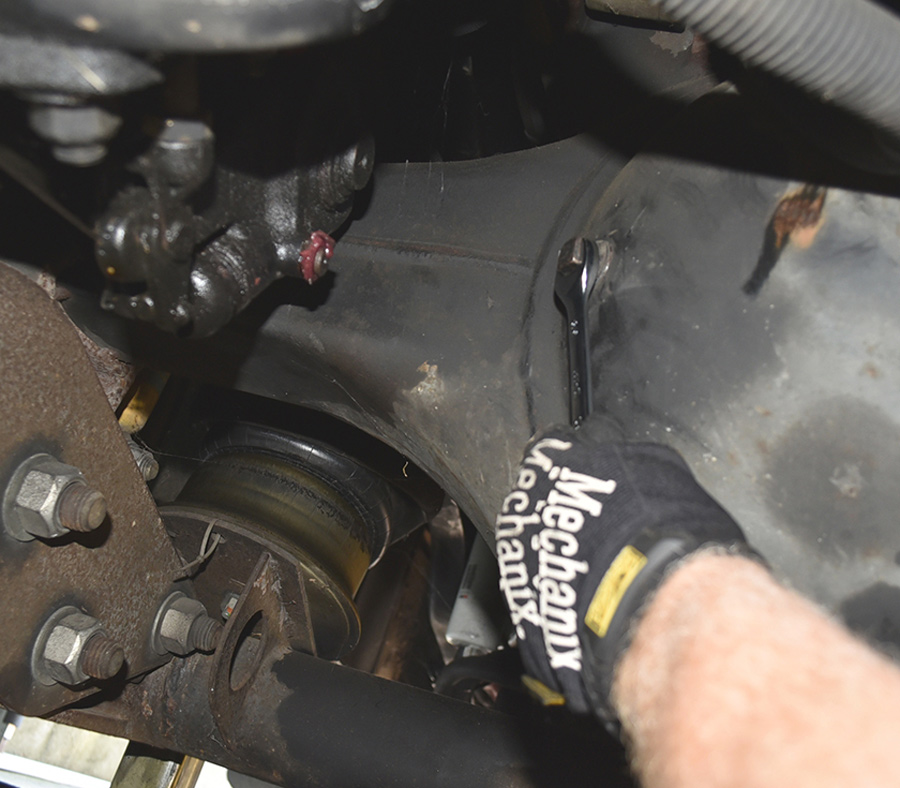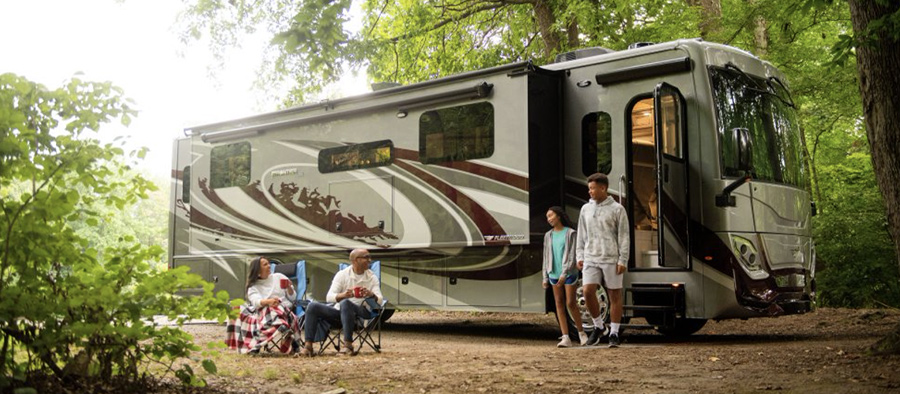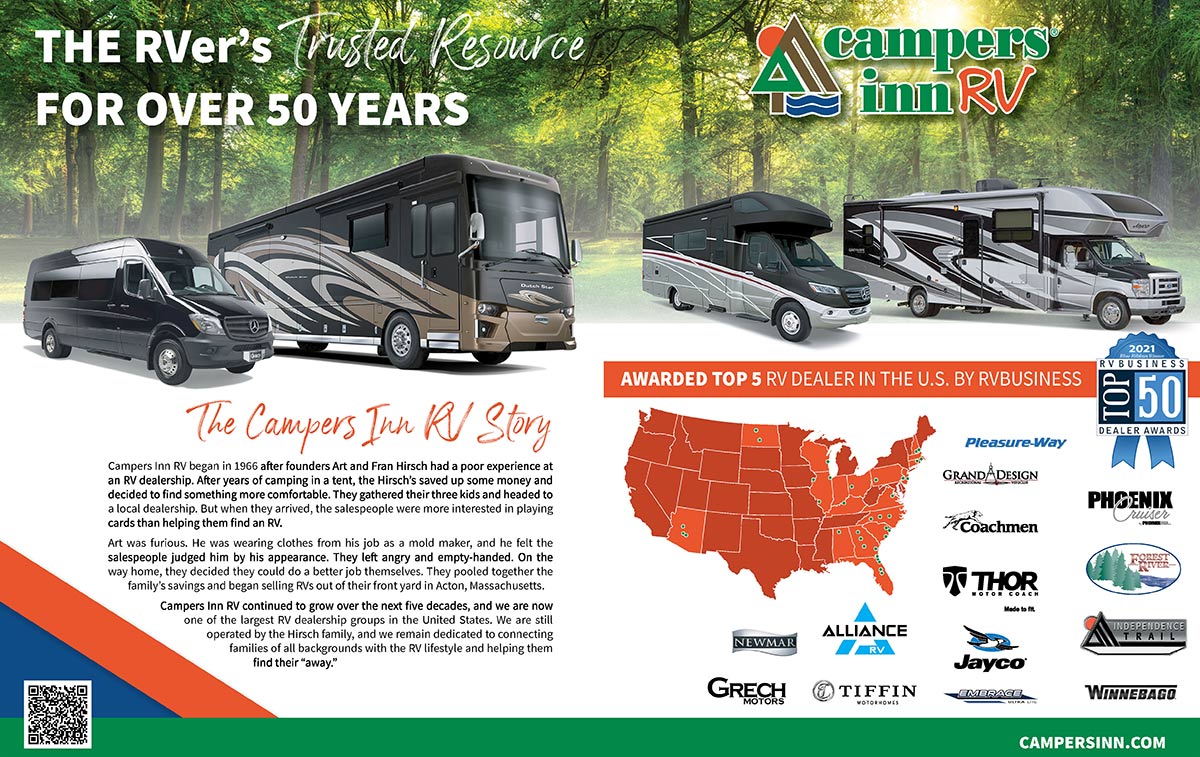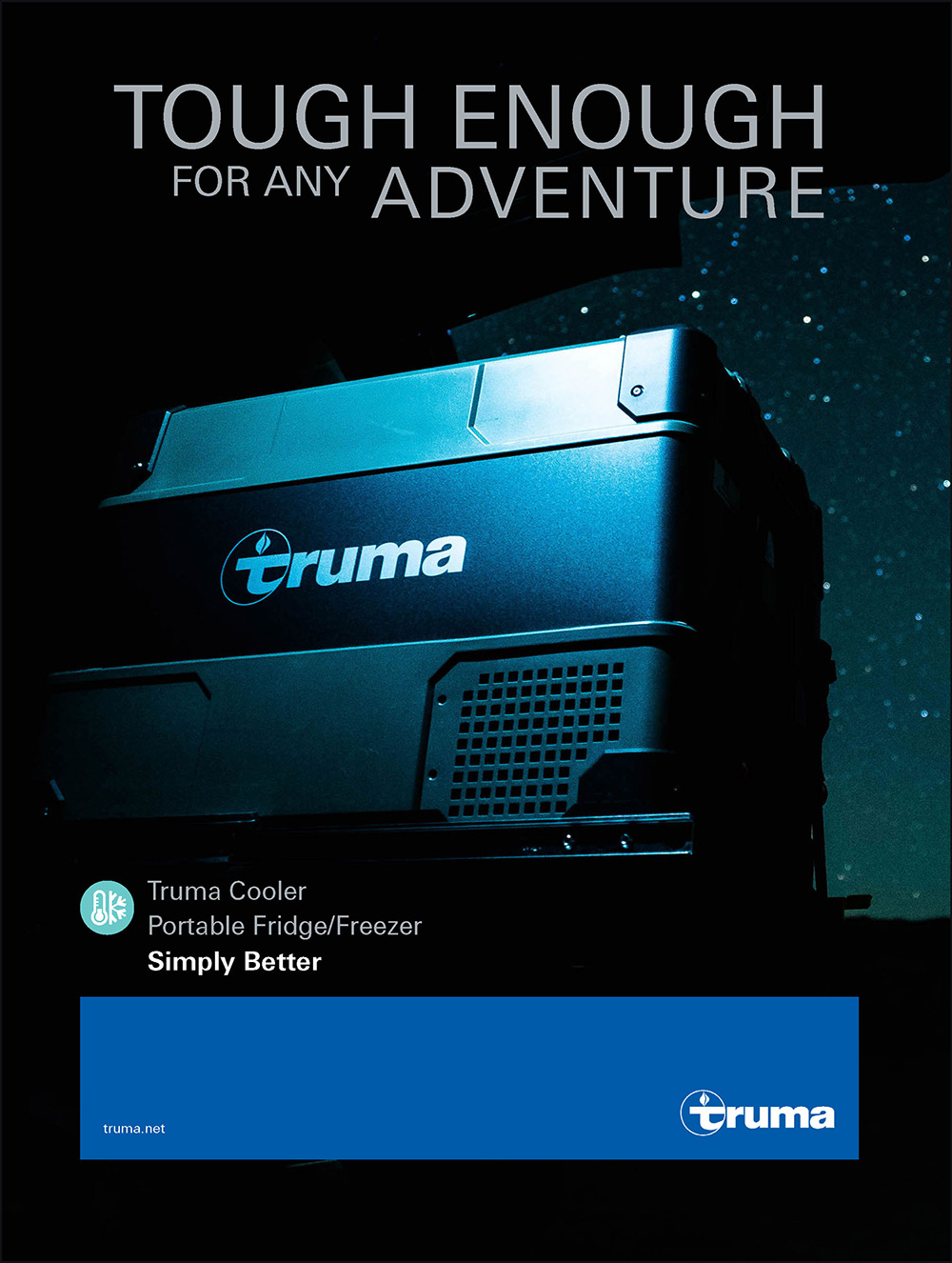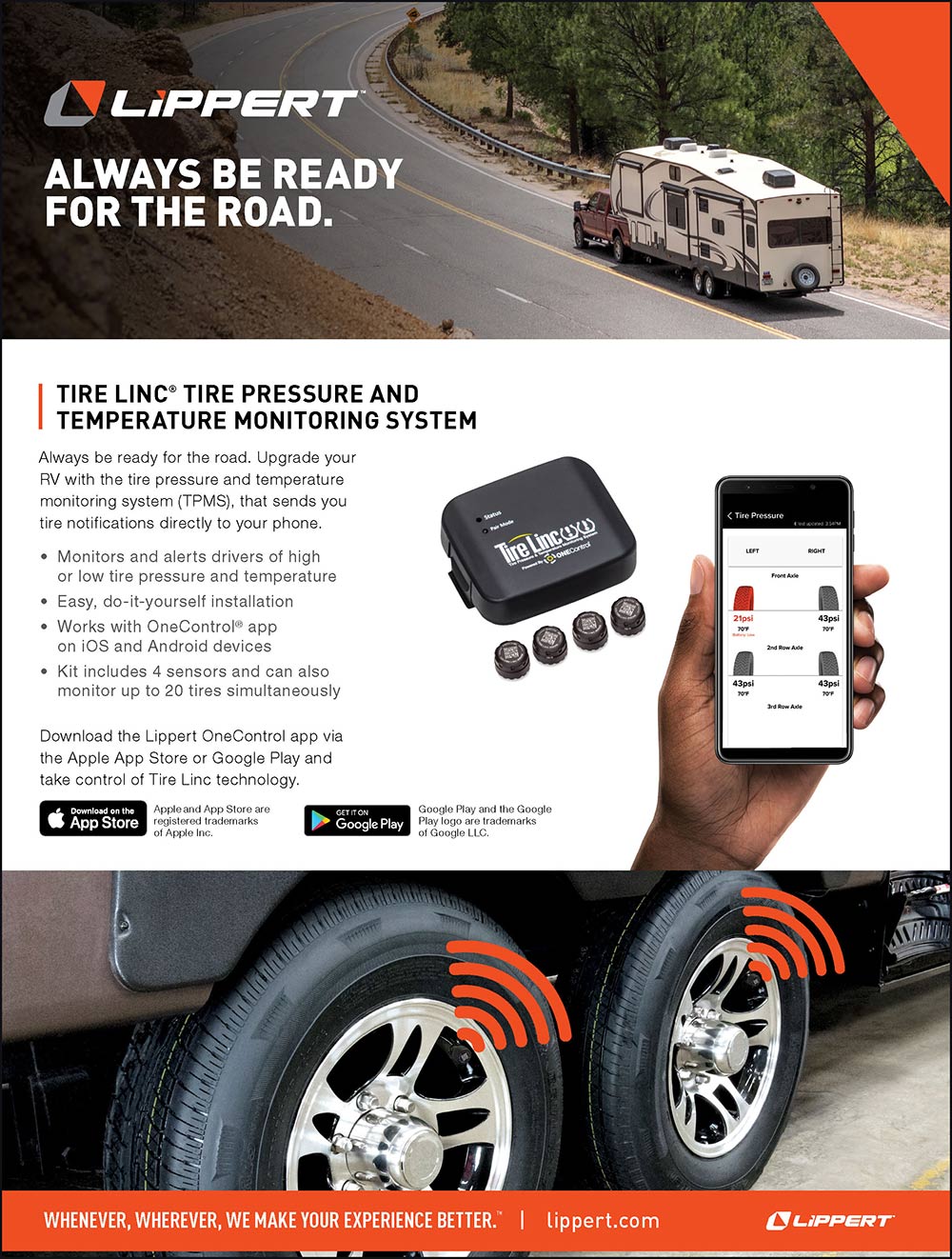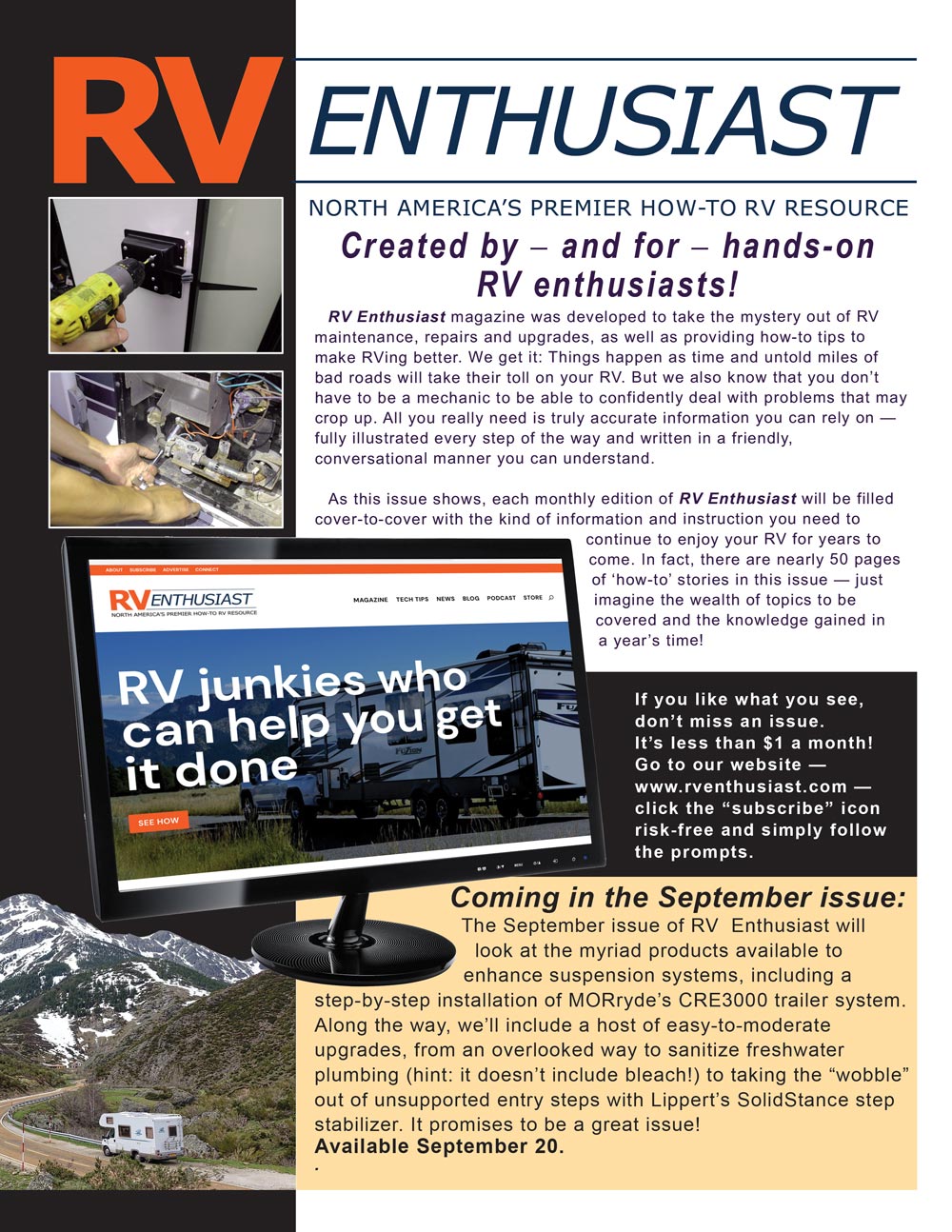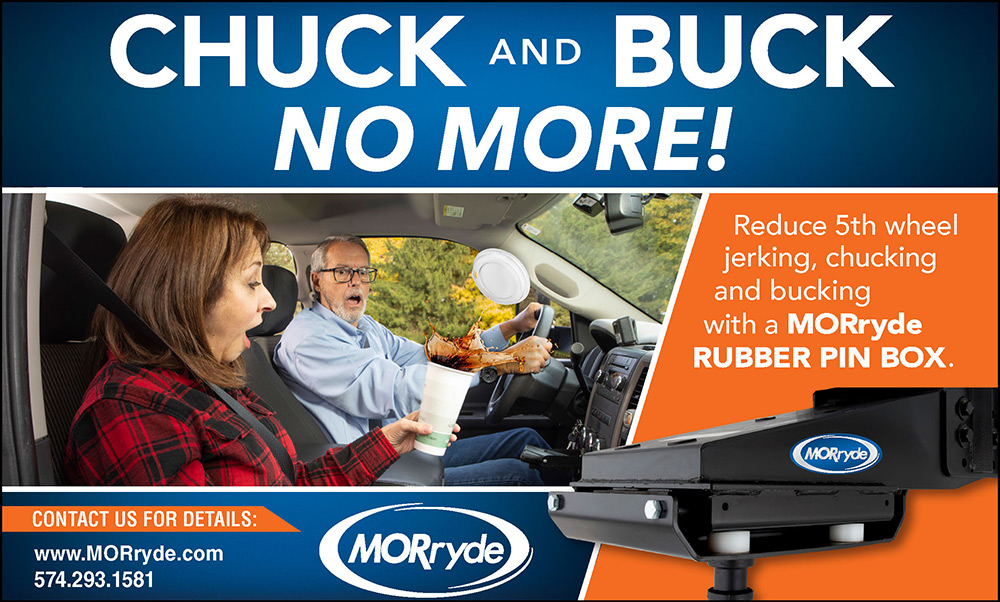Subscriber Access Only
Special Offer
Get 1 year of RV Enthusiast Magazine for just $9.99
Unlock My Offer No ThanksAlready a subscriber? Click here to access full issues.
- Multiple cooktop surfaces in one compact griddle
- Available in 17” and 25” models to fit needs of all sizes
- Simple installation — just needs a gas hook-up — and easy to store
- Interchangeable cast iron flat-top griddle and grill grates for different cooking options
- 15,000 BTUs of output for high heat cooking
- Easy to hook up for outdoor RV kitchens
- Over 250 square inches of cooking area: perfect for preparing full meals for family and friends

Motorhomes were made for the movies. If they hadn’t been invented, someone would have come up with the concept for movies? Why? Because they are the perfect foil — big enough to carry a lot of people and “armed” with the type of onboard systems that are perfect for comedic relief. Can you say “toilet humor?” We listed our choices for the top 10 movies to feature a motorhome in a starring role.
The 120-volt AC heating element in a hot water tank is one of those overlooked parts that stay out of mind — until, of course, it fails, usually while on a trip. Replacing this element is a simple project for any do-it-yourselfer. In fact, if yours has some years on it, you might want to be proactive and replace it now — before it stops functioning. You never know when replacement parts become backordered.
As the ongoing boom in RV sales continues, it’s fueled efforts to engineer and build ancillary products within the RV arena — and nowhere is this as prevalent as within the hitches-and-towing segment. As less-experienced RVers hit the road, companies are working overtime to create new products to keep them safe.
Perhaps one of the most overlooked maintenance items in a motorized RV or two vehicle is the rear differential. Converting engine output into rotational force creates a lot of heat, however — and gear oil will eventually break down and need to be replaced. It’s not a complex job — but it can be messy

(805) 320-6909
[email protected]
EDITOR – Bruce Hampson
(574) 584-4616
[email protected]
TECHNICAL DIRECTOR
BILL GEHR
(805) 340-5015
[email protected]
ART DIRECTOR – MIKE ACCUARDI
[email protected]
26362 Douglas ave., Elkhart, in 46514
 AFFILIATE NOTICE: RVE Media Group LLC provides links to vendors and products, such as an Amazon Associates account, for informational purposes, but that may provide a commission if you purchase from that link. We often label these links with language that provides transparency if the destination is an advertiser, affiliate, or partner. Products are often provided to RVE at little/no cost for editorial testing purposes by vendors/suppliers. Under no circumstances does this affect the results of the test or install as published in RV Enthusiast. Sponsored content is identified as such directly on the content.
AFFILIATE NOTICE: RVE Media Group LLC provides links to vendors and products, such as an Amazon Associates account, for informational purposes, but that may provide a commission if you purchase from that link. We often label these links with language that provides transparency if the destination is an advertiser, affiliate, or partner. Products are often provided to RVE at little/no cost for editorial testing purposes by vendors/suppliers. Under no circumstances does this affect the results of the test or install as published in RV Enthusiast. Sponsored content is identified as such directly on the content.
PRIVACY POLICY: Our complete privacy policy can be found at https://rventhusiast.com/privacy-policy/
istakes are part and parcel to doing business. Anything made by humans is bound to have a hiccup on occasion — and RV manufacturing is more labor-intensive than most any other product made for travel. When you get down to it, they almost have to be — can you imagine trying to design robotic arms capable of negotiating the myriad walls and products being built into an RV in order to install just one portion of it? And more to the point: can you imagine how much the typical RV would cost if manufacturers had to implement such expensive systems?
That said, when RV recalls are announced they tend to assume a larger-than-life impact, courtesy of social media. Now, I’m not a cheerleader for the RV industry. The huge growth in the RV lifestyle propelled by the COVID pandemic caught the industry unaware and manufacturers started having to play “catch up” by bringing in a lot of new employees, adding shifts and even adding new facilities. Obviously, new hires can and will make mistakes. However, it’s mildly infuriating to read of potential new buyers being warned off from “COVID builds” (specifically, 2020-2022 models). Yes, these online groups are filled with hundreds of stories — some of them cringe-worthy — detailing problems owners encountered while trying to enjoy their new rigs. However, those numbers have to be seen in perspective: during this same time period, the industry built and sold about a million RVs. Naturally, this part of the storyline is usually overlooked.
Sponsored Content
Do Your Homework
With new-unit dealer inventories still off pre-pandemic levels, sales of used RVs continue to rise — forcing customers to purchase vehicles with no remaining original factory warranty (OFW). This is where protecting your investment comes in. Look for nationally recognized providers that are accepted in the United States and our northern neighbors, Canada.
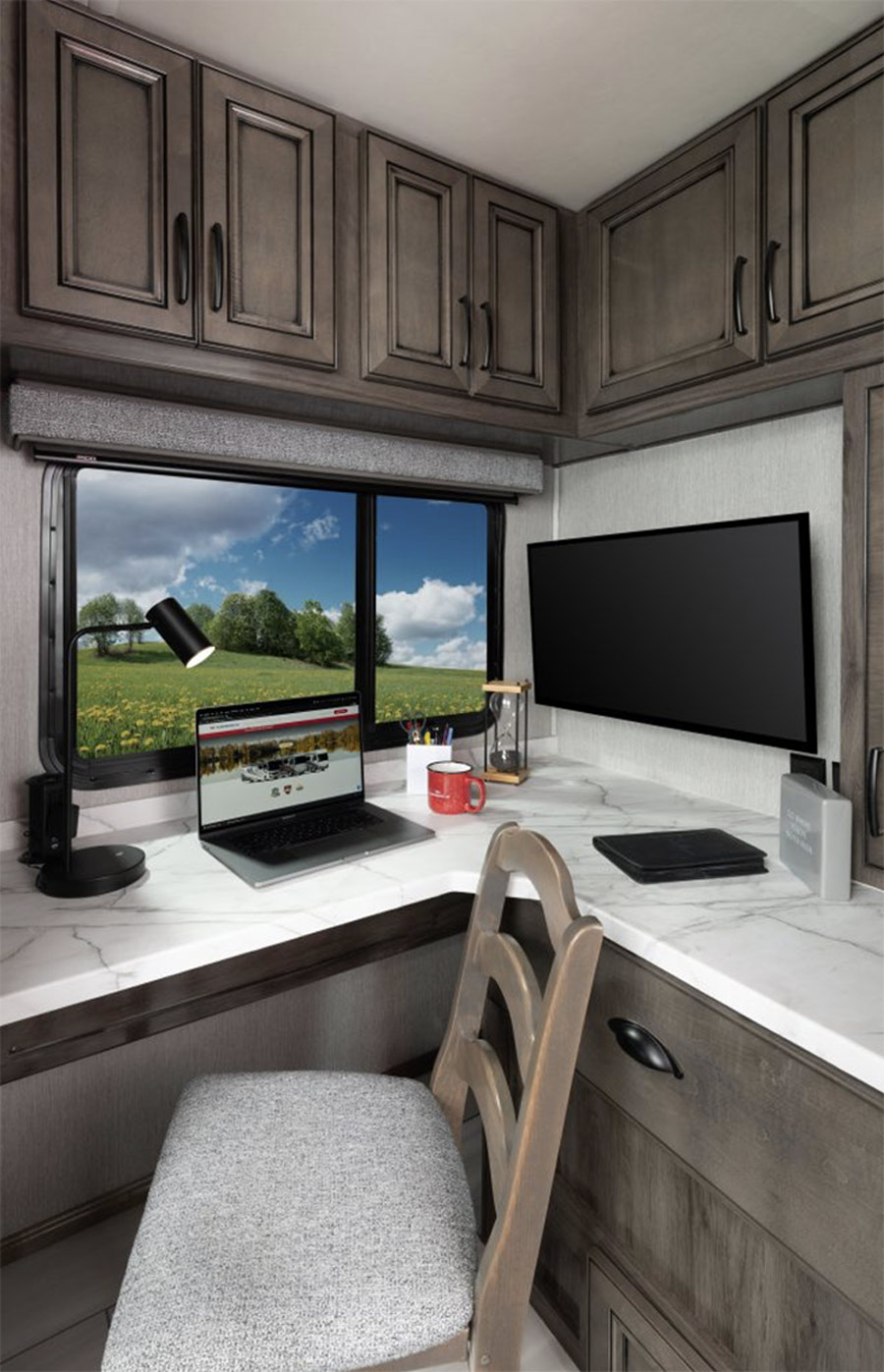
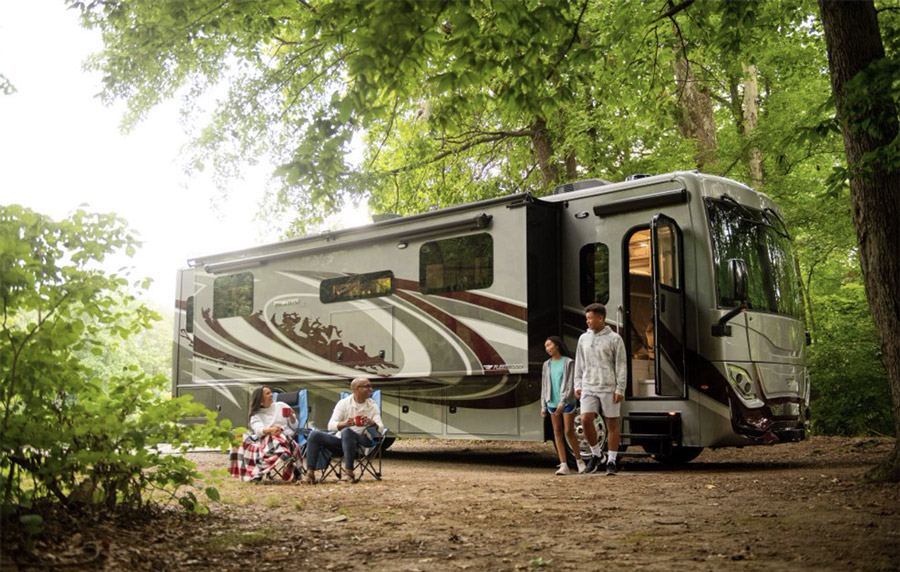
Built on a Freightliner raised-rail chassis powered by a Cummins 7.6-liter 360-hp diesel engine, the Frontier GTX 37RT is a 37-foot motorhome with three, flat-floor slideouts that deliver plenty of interior room. The Corner Office is an option and is strategically located at the rear of the coach so it’s away from daily life activities.
The space is cleverly arranged and includes an L-shaped desk with a built-in monitor and multiple nearby outlets. A large window tops the desk to bring in natural light and deliver a view of the outdoors. Drawers below and cabinets above provide convenient storage within easy reach for files and other supplies. A stylish barn door of frosted glass and wood closes off the space when ultimate quiet and privacy are needed. To ensure phone and video calls go off without a hitch, the GTX offers an optional connectivity package that includes WiFi Ranger Sky4 ProPack w/LTE and weBoost Cell Booster.
For more information, visit fleetwoodrv.com/models/frontier-gtx/.
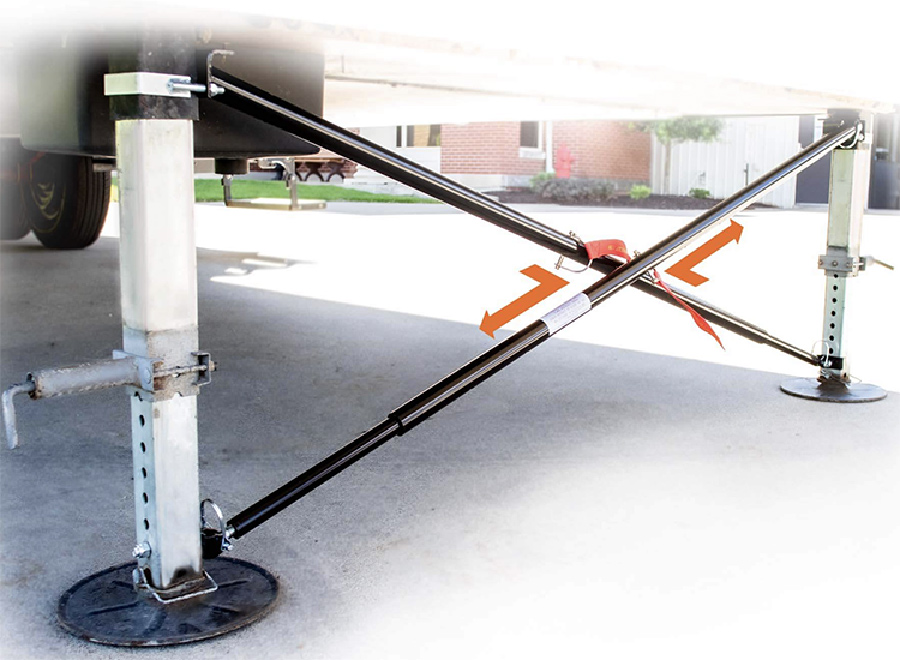
— Edward Perez
The kingpin stabilizer is not very effective; you need something that uses multiple points on the fifth wheel to prevent movement. Take a look at the MORryde X-Brace Stabilizers (morryde.com). The X-Brace has multiple connection points and provides good lateral support that takes the wiggle out of chassis movement. It will stop the side-to-side and front-to-back motion that makes your wife uncomfortable. Likely, installing just the front stabilizer will squelch the unwanted movement, but you can also opt for a rear-mounted system. If you are somewhat handy, you should be able to install the X-Brace system in a couple of hours.

Who will ever forget John Cusack’s character, Jackson Curtis, racing through Yellowstone National Park in a real fireball of a Winnebago?
otorhomes were made for the movies. If people like Roland Conklin and Raymond Frank hadn’t created and improved upon the concept of a self-sufficient home on wheels for outdoor enthusiasts, someone would have come up with the idea for movies.
Why? Because motorhomes are the perfect foil.
For starters, they are big enough to house a whole gang of people — and with most films, the more characters a movie has, the more opportunities to create comedic relief or, conversely, conflict. Then, too, motorhomes carry enough “armament” — in the form of onboard systems which, in movies, are prone to failure or misuse — to carry most movie scripts. Especially when dealing with, well, scatological references. You know, toilet humor.

Hot
Topic
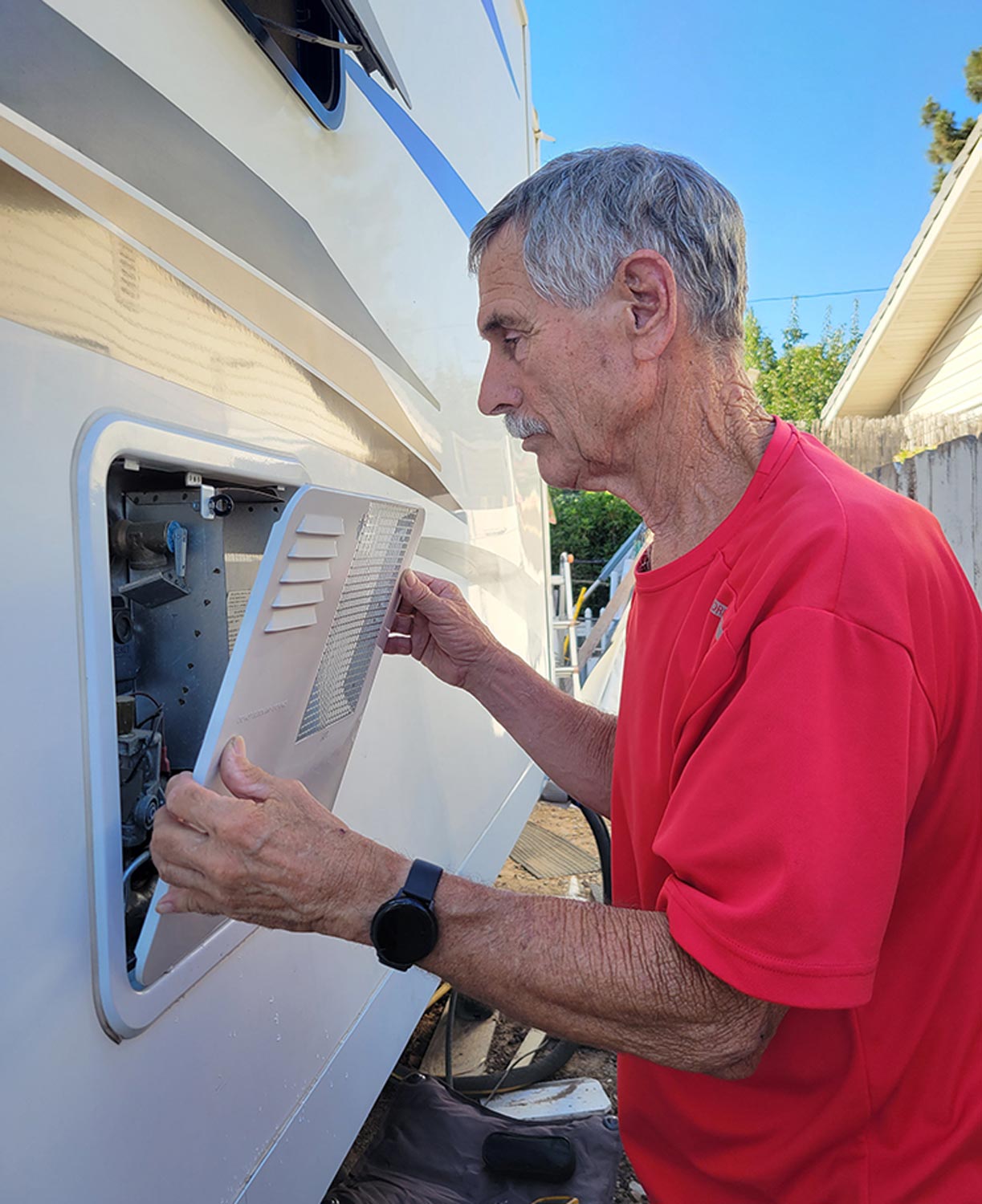
f you’re like most RVers, you turn on the appliances and just expect them to work, never thinking whether there’s a finite life to trouble-free service — especially when the RV is used full time. Unfortunately, size requirements to fit into tighter spaces inside motorhomes and trailers dictate appliance function and maintenance. Couple this consideration with the weight limitations to comply with chassis and tire ratings (as well as balance) and RV appliances typically are not built to withstand endless years of rigorous service like most home appliances.
Case in point: the electric heating element in my Suburban water heater.
While it still functioned, its days were numbered after being in service full time since 2010. Frankly, it’s hard to believe it didn’t burn out long ago.
And, we test everything we make. Not 1 out of every 100, or 1 out of every 50. Every. Single. One.
Why? Because as our founder is fond of saying, “You can’t tack on ‘quality’ at the end. You have to build it in.”
What does it take to control every phase of design, engineering and manufacturing? Well, consider:
- Roadmaster owns more than 1,200 jigs just for the brackets used to attach tow bars to vehicles. These jigs allow us to manufacture brackets for approximately 2,000 years’ worth of years, makes and models.
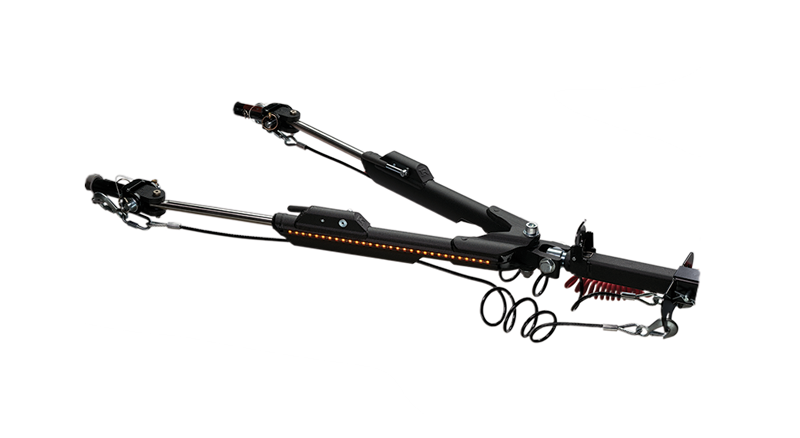
Longest lasting – Easiest to use
Non-binding design
Built-In channel guides
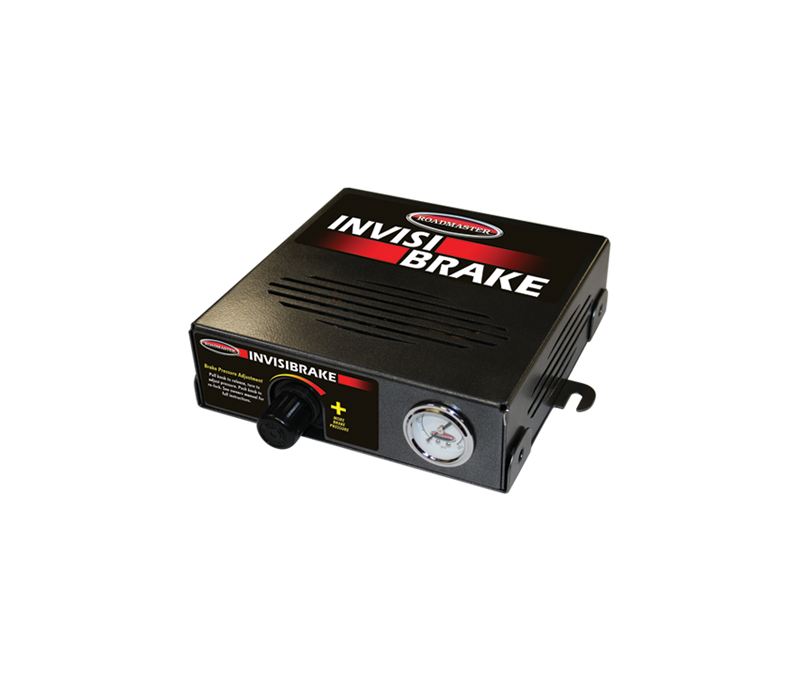
Hidden from view
Simple operation
Charges your battery
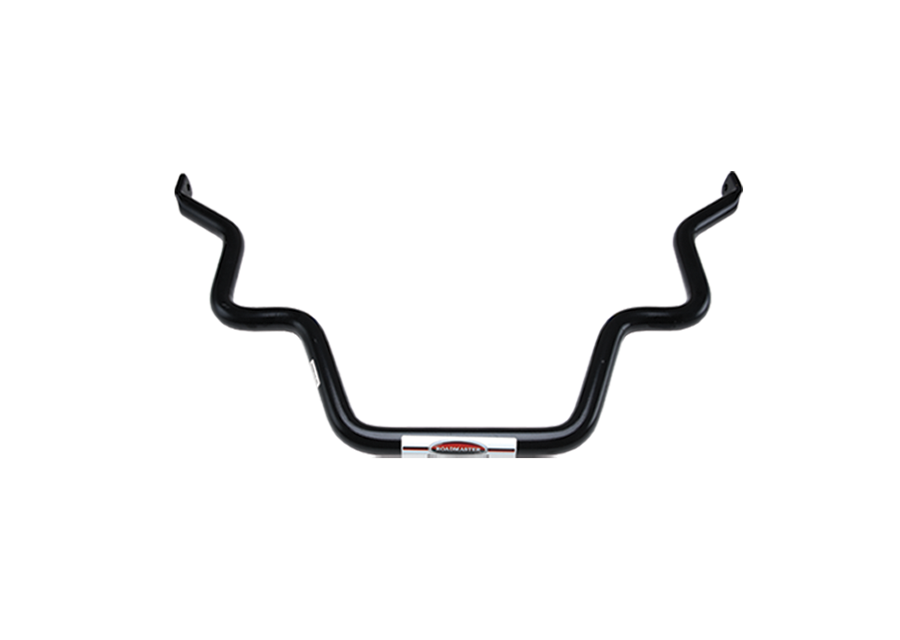
More resistent to sway
Higher-grade alloy
Better pivot point
s the ongoing boom in RV sales continues, it’s “supercharged” efforts by manufacturers and suppliers to design, engineer and build ancillary products within the RV arena — and nowhere is this as prevalent as within the hitches-and-towing segment.
Let’s face it: The surge in RV sales has put countless numbers of less-inexperienced RVers on the road. It stands to reason that equipping them with premium hitches and towing products — as well as wheels, brakes, sway control, suspension and all of the myriad other running gear upgrades — can only be a good thing, for them and the rest of us.
With that in mind, we spoke with executives of major companies involved in the hitches-and-towing products arena to get their viewpoints on not only the evolving RV lifestyle but the products these and other companies have released recently to improve upon it. And, keying on safety, we’ve added components from other companies that also tie into the need for being road-worthy.
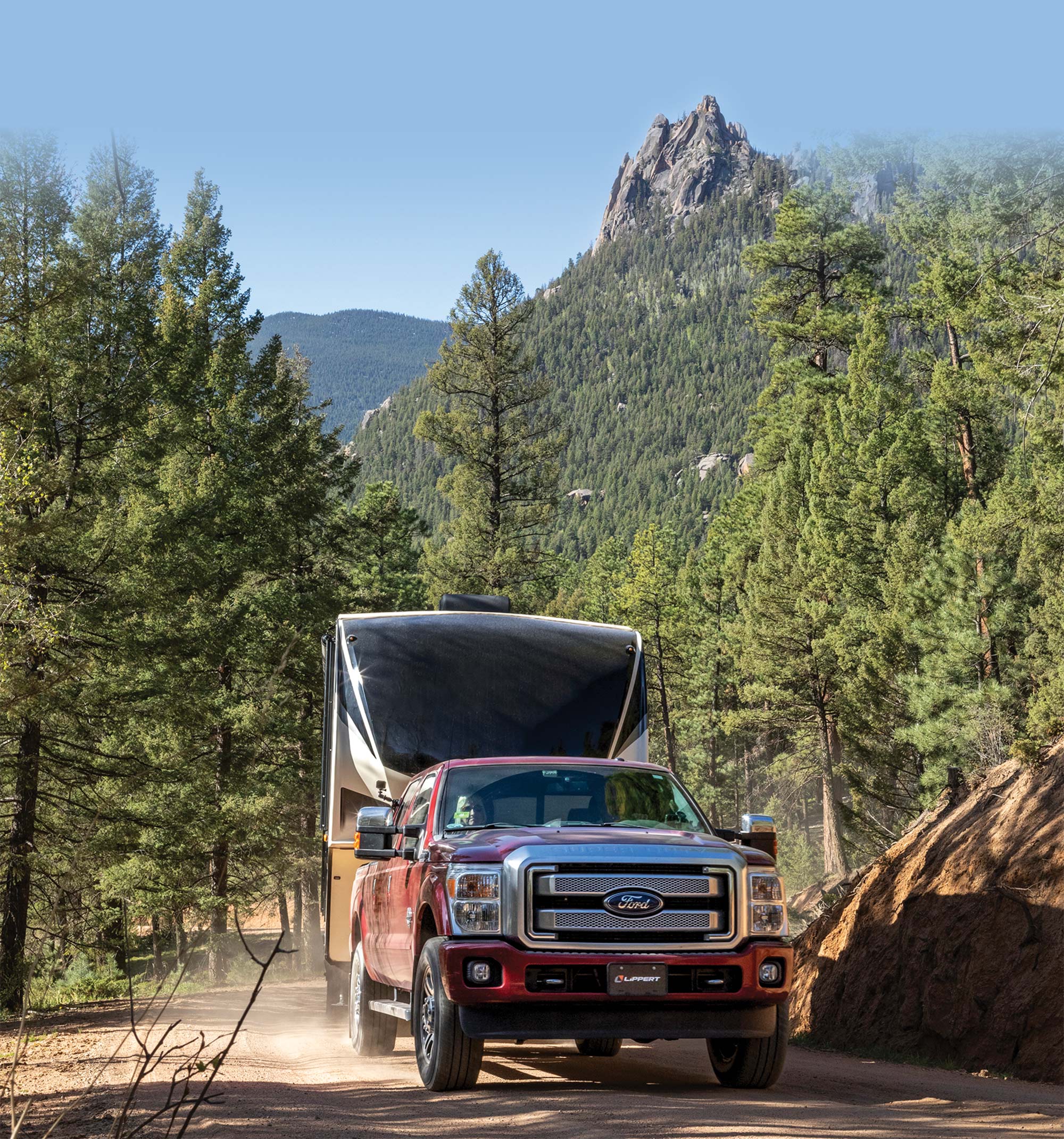


erhaps one of the most overlooked maintenance items in a RV or a tow vehicle is the rear differential. In any rear-wheel-drive vehicle, it is the rear differential that accepts the engine output and converts it to rotational force sufficient to propel the motorhome/tow vehicle forward. Not surprisingly, transferring this force can build up a lot of heat, which is why the large ring-and-pinion gear inside the differential is partially submerged in gear oil — that oil is there to not only lubricate the gears but also to cool them and prevent corrosion. And much like an engine, that oil will eventually break down and need to be replaced.
The process of changing gear oil is one of the simplest of all the maintenance items on a motorhome or a tow vehicle, yet many people are afraid to perform it themselves. Granted, simple doesn’t always mean easy — but with only two wrenches required and two oil plugs, there really isn’t much to this chore in terms of complexity. The only real challenge to doing this yourself is the volume of fluid that has to be handled. In the case of this Freightliner Class A motorhome, the rear differential holds 17 quarts. That’s almost five gallons, and capturing and refilling the oil is the only difficult part of the entire operation. Fortunately, most trucks and SUVs have a much smaller differential; therefore, it’s a lot easier project to undertake.
Clearsource
Lance Camper
Lippert
United States Warranty Corporation
Way Interglobal
Advertise Today
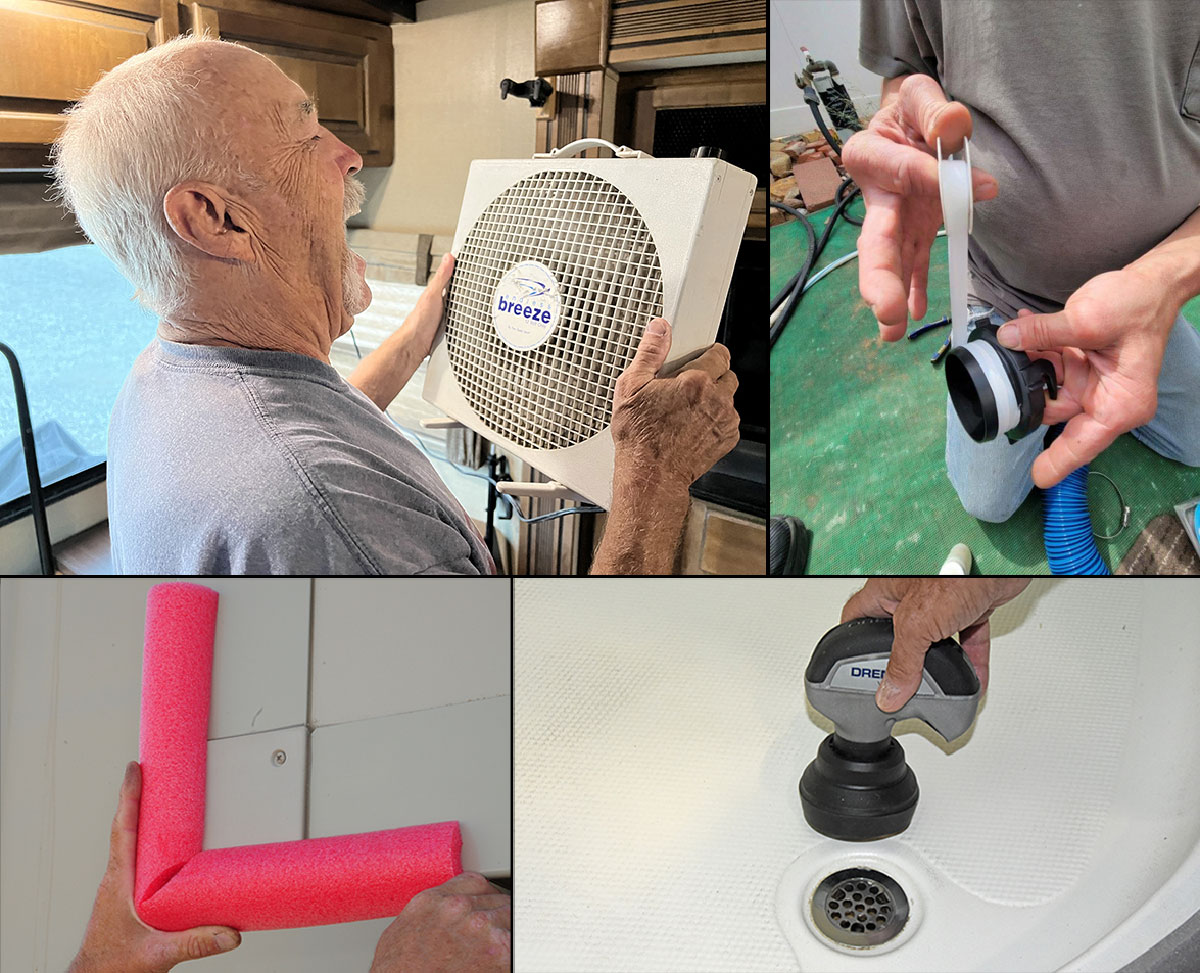
ontemporary RVs really are nothing short of amazing. The fact that most incorporate virtually every requisite comfort feature found in a typical brick-and-mortar home makes the term “roughing it” something of an oxymoron today.
That said, RV designers and engineers have pulled off this feat in a much smaller and weight-restricted environment — meaning you are limited in what you can take with you when the time comes to, say, clean up your rig. RVs also present a unique set of challenges, forcing most owners to become reasonably adept at troubleshooting everything from plumbing fixtures to electrical systems. There really is no question of “if” something goes awry — it’s just a matter of “when.”
And “when” that happens, it’s nice to tap into the experience of others who have traveled that same road before you.


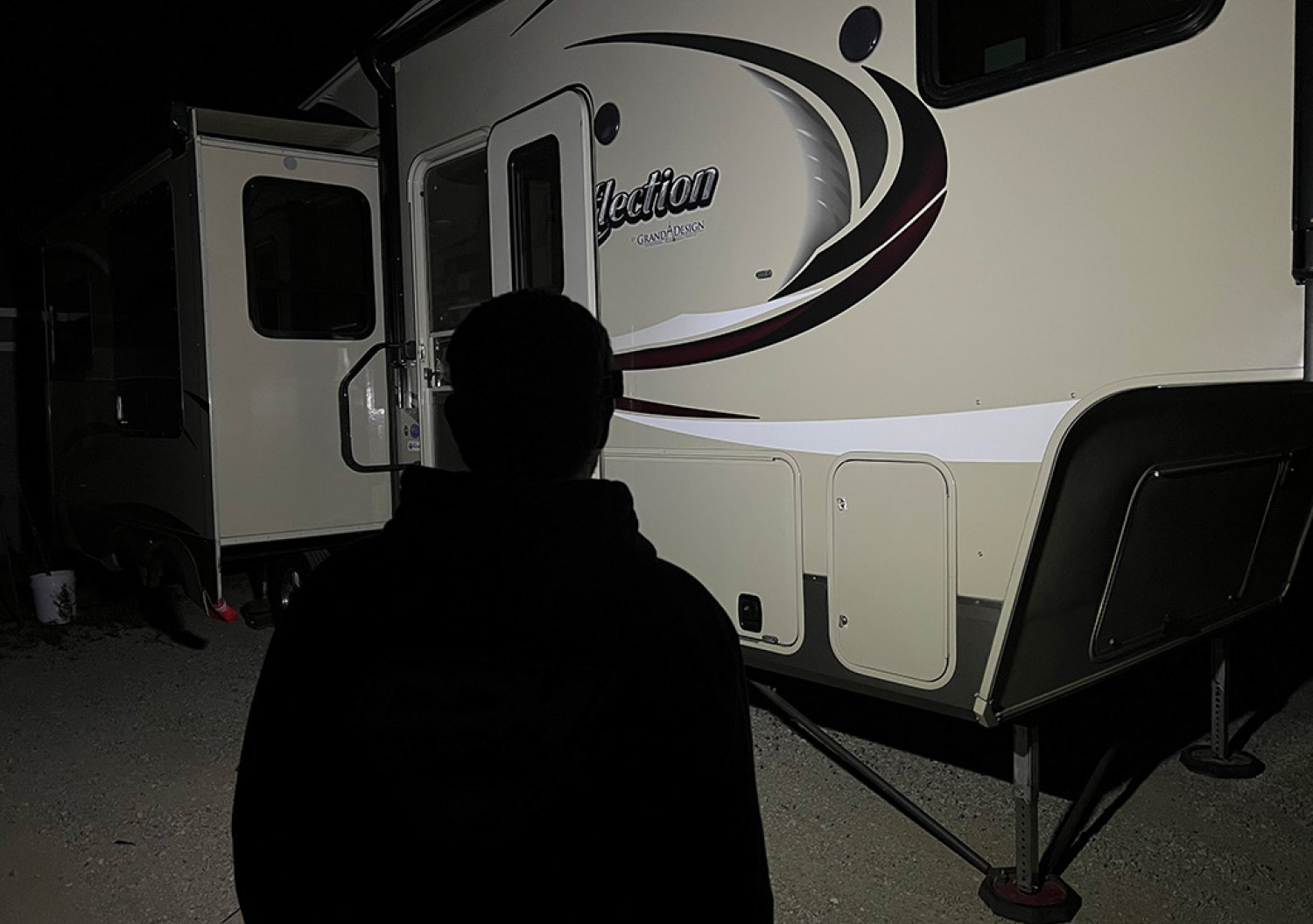
flashlight is probably the most common tool found in RVs. There are dozens of uses for extra portable light, and flashlights make it possible to navigate dark places like inside storage areas, engine compartments, sidewalks — you get the picture. Unfortunately, humans only have two hands, so working on projects (or carrying groceries) where extra light is needed can be frustrating when having to use one hand the hold a flashlight. Headlamps, though, are practical tools; just ask outdoorspeople who attach them to their hats or foreheads to move around at night.
I’ve used headlamps for years, and most of them are unwieldly and only provide basic, focused lighting — not to mention wrestling with drooping headbands. But that’s before the All Perspectives Induction Headlamp came on the scene.


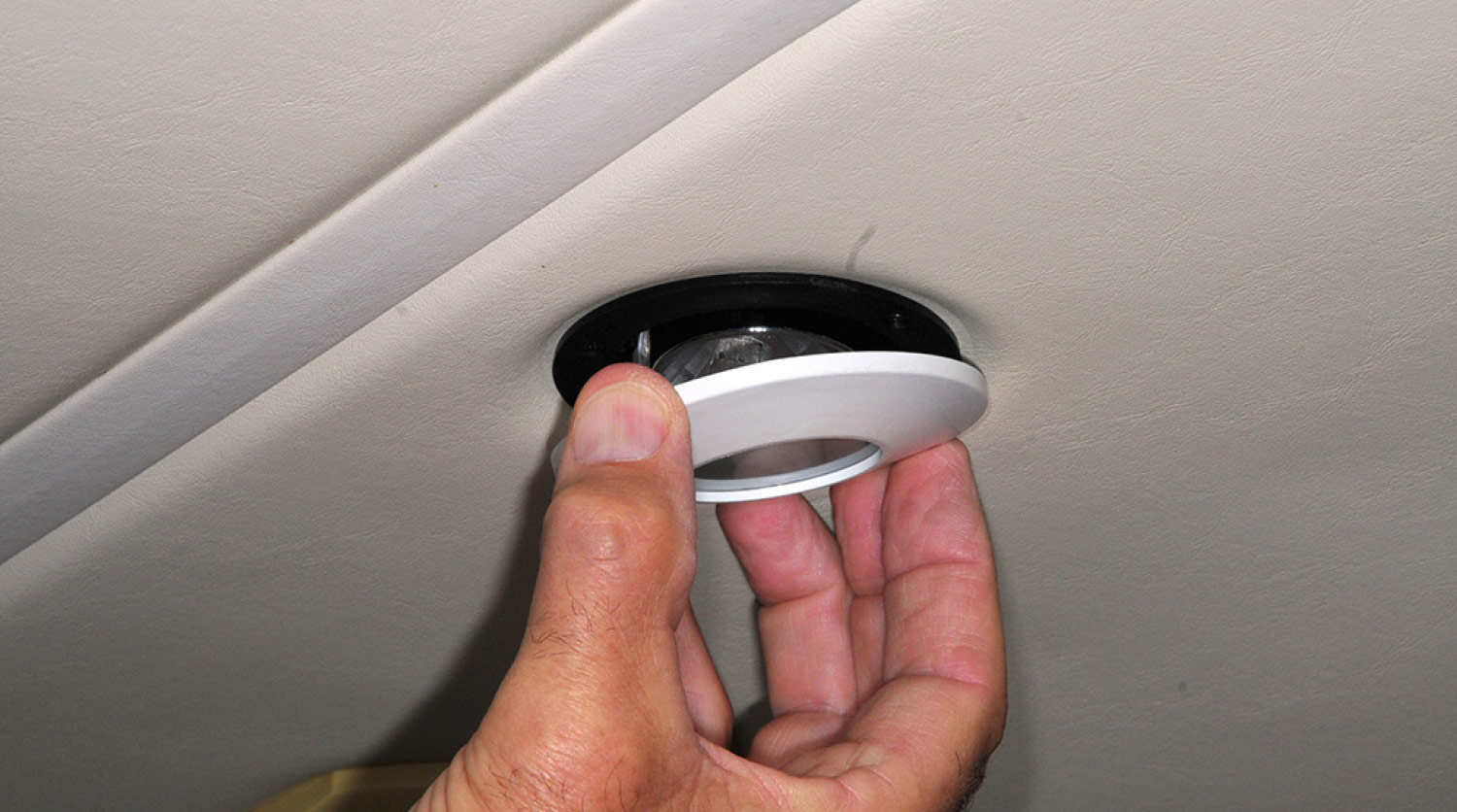
nterior RV lighting has gone through a number of transitions over the years, and halogen bulbs at one time were more fashionable. These bulbs emitted quite a bit of light and were easily tucked inside puck-style fixtures that added a big touch of modernism to any ceiling or under countertops. The downsides are higher energy requirements and tremendous heat — halogen bulbs draw twice the amperage of their incandescent counterparts. Small reason why LEDs quickly — which use only a tiny amount of energy — are now the bulb of choice. Fortunately, it’s easy to swap out the existing halogen bulb with an LED disc, and it only takes a few minutes.
The first step is deciding on the LED bulb that best suits your needs. As usual, the Internet is loaded with product in this arena. There are different light temperatures and lumen ratings: the higher the temperature, the brighter the light — and, the higher the lumens, the brighter the light. You may prefer a higher-temperature LED, rated around 5,000 Kelvin, in areas where bright light is needed, while a softer, more yellow tint of a 3,000-Kelvin bulb may be more desirable in areas where you lounge.


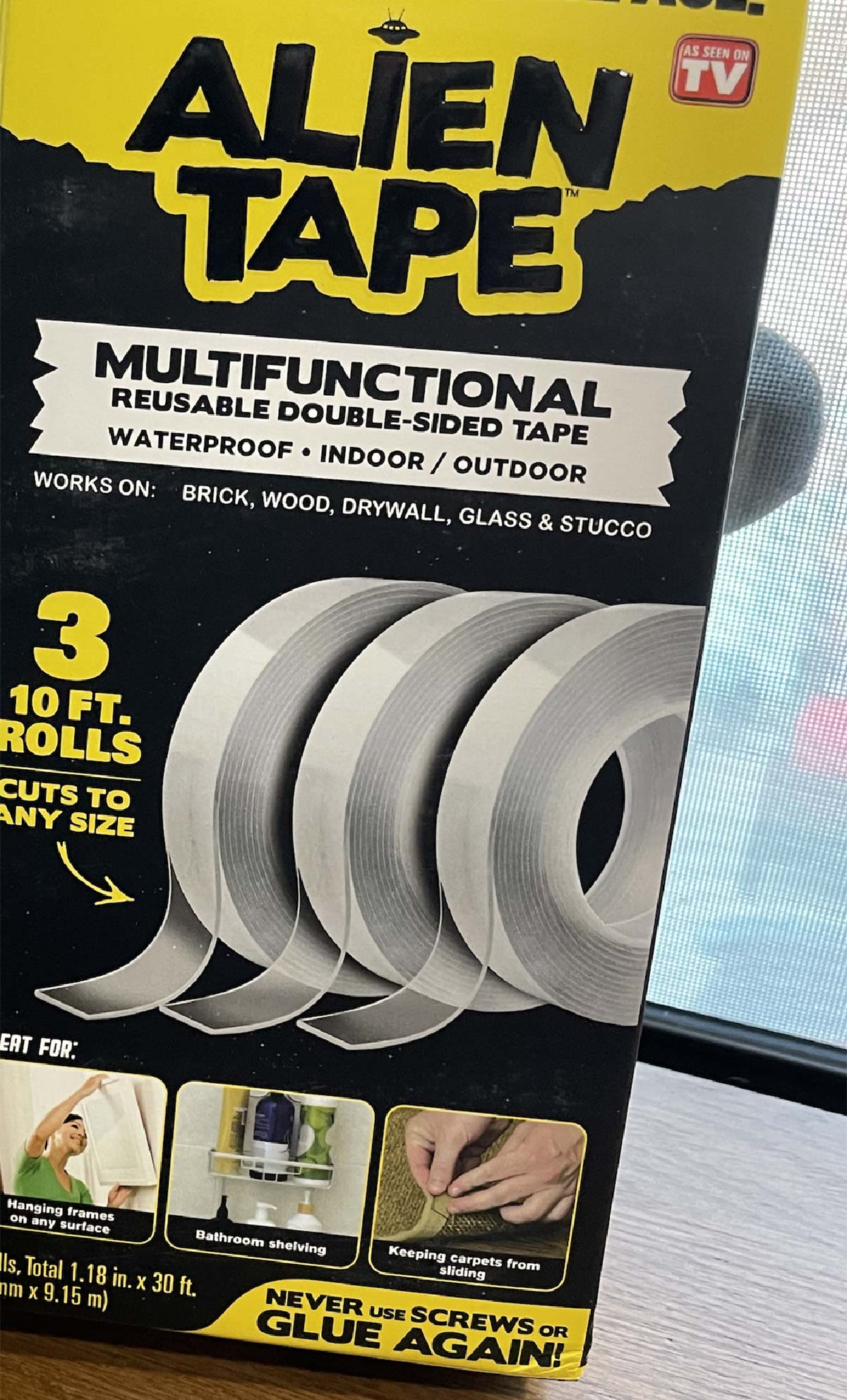
ometimes, the “hurry up and wait” lifestyle common at times to RVing can play havoc with your sleeping pattern. At least, that’s where I found myself one night after a late check-in at a campground and the requisite setup. Yup, the clock may have signaled for a slow-down, but my mind was having none of it. So while my wife, Lynne, headed off to dreamland, I sat up with the “boob tube” for company — and, as luck would have it, caught the end of an informercial for Alien Tape.
What attracted my attention was the product’s claim to hold items without screws or glue. Watching a heavy item “stick” to the wall in seconds also piqued my interest, so I took a chance and bought the stuff online. And, well, I was pleasantly surprised once I received it and put tape to practical use.


For those without sophisticated remote monitors. keeping tabs of 12-volt DC consumption when camping off the grid can be as simple as adding a $20 amp meter.
amping off the grid presents several challenges — one of which is managing battery power. Whether you have one battery or a bank of six, having the capability to monitor amperage draw can make a big difference when estimating how often you need to recharge the batteries — and if your system is capable of getting the job done. A solar system takes some of the guesswork out; however, several days of rain or clouds will affect charging status.
Inverters can be the biggest battery drain, depending on how many appliances are operating throughout the day. There are a few options for monitoring battery levels and, for the most part, these remote gauges are tied into the inverter or solar system and can be rather expensive; retrofitting can also be labor-intensive. However, an inexpensive induction amp meter can give you a general real-time battery condition along with your onboard voltmeter. Then, if you keep a log of voltage in conjunction with the amperage draw, it’s possible to figure out how long the batteries will provide enough power to the inverter before shutdown occurs.


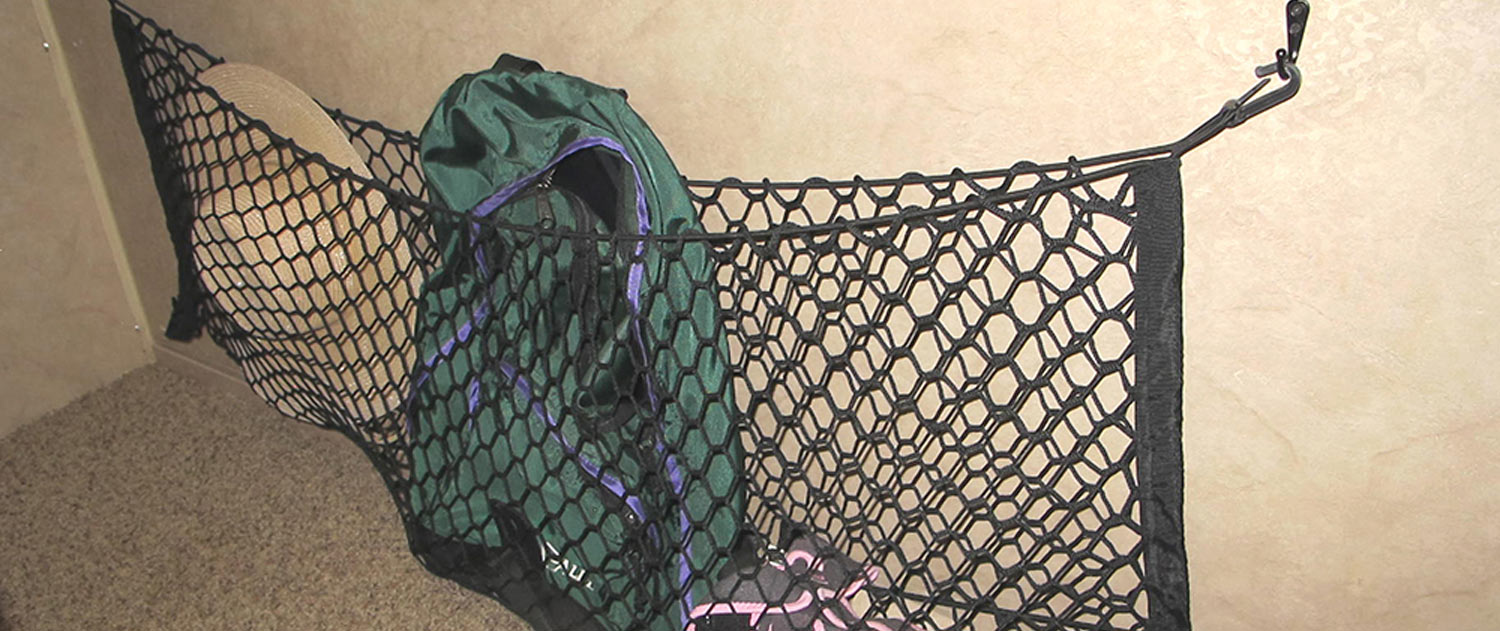
ave you ever heard anyone complain about having too much storage in their RV? Neither have I. Just about everyone looks for ways to improve the storage capabilities both inside and outside their RVs. And while most people have leftover vertical space at the back of their wardrobe closet(s), the quandary is figuring out a way to utilize this unused real estate. Then the light bulb illuminated: Why not use a cargo net designed to hold stuff in the bed of a pickup truck to keep things from going airborne in the closet? These nets are commonly found on the Internet. I located the Karcoca Cargo Net for Pickup Truck Bed on Amazon for $25.21; it’s designed for Ford F-150 and GMC pickups. The net measures 18 x 59 inches, but if you don’t have room there are shorter ones available from the same manufacturer and others.
The real trick was figuring out a method for hanging the cargo net in such a way that it could actually hold items securely that otherwise just got in the way. In my case, the unused space in the back of the closet presented a perfect location for storing yarn that is used for crocheting, seasonal games that have little weight and other bulky items like hats. It took some time to figure out the best method for fastening the cargo net, which came with four carabiners. I opted to buy some hooks and clips at a local hardware store that made the installation simple and quick.


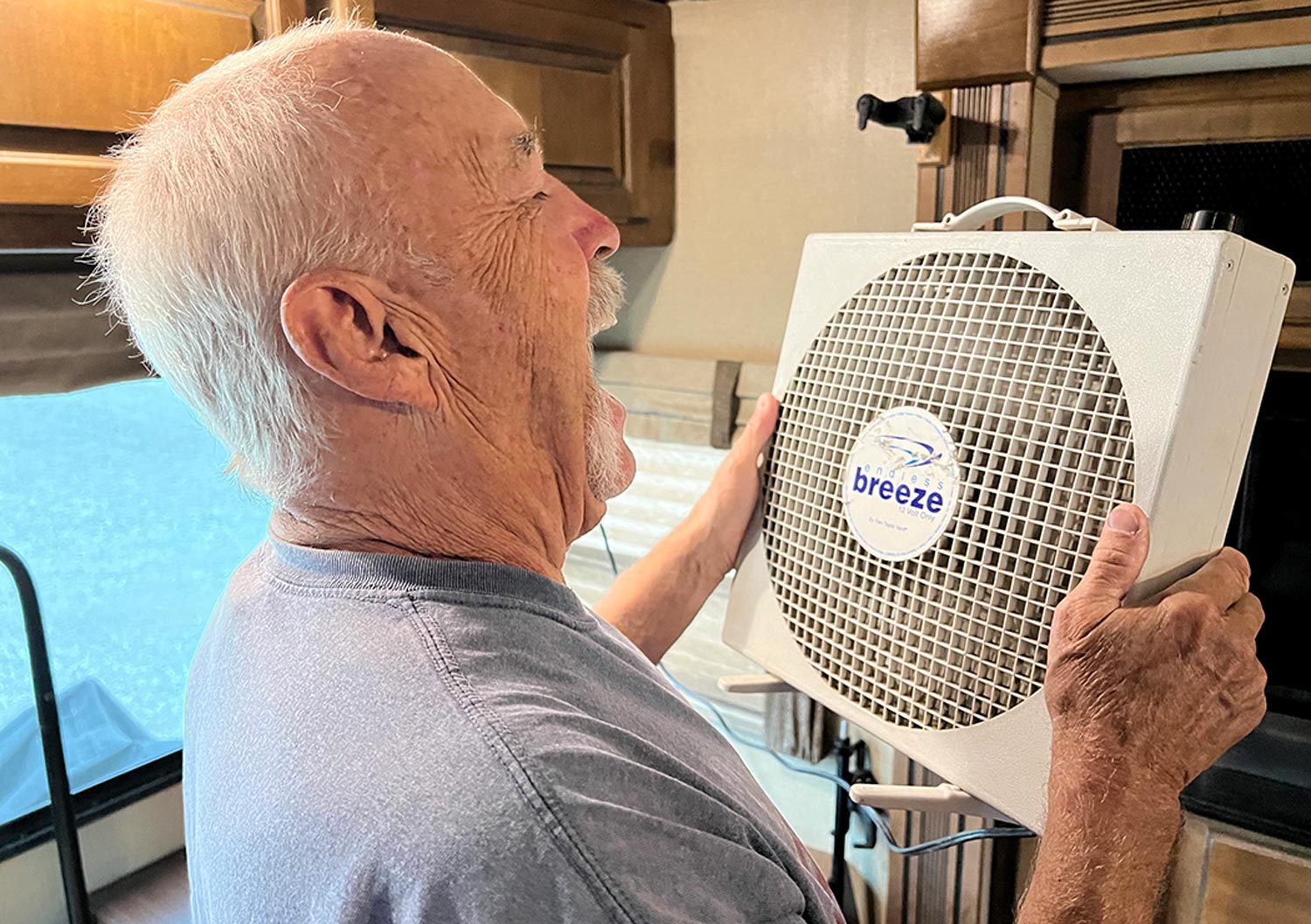
hen ambient temperature soars, the amount of air moving inside the RV will make or break a trip — especially if hookups are not available. Adding roof-vent fans like those from Fan-Tastic Vent and Maxxair really help push hot air out or move cooler air inside. RVers commonly use these roof fans to pull air from open windows in the bedroom and across sleeping quarters.
Having a portable fan helps, but just about all the ones found in home improvement stores operate on 120-volt AC, which requires hookups, generator power or an inverter. Because of that, one of the most versatile fans is the Fan-Tastic Vent Endless Breeze, which operates on 12-volt DC power and can be placed virtually anywhere so long as it can be plugged into a standard round outlet.


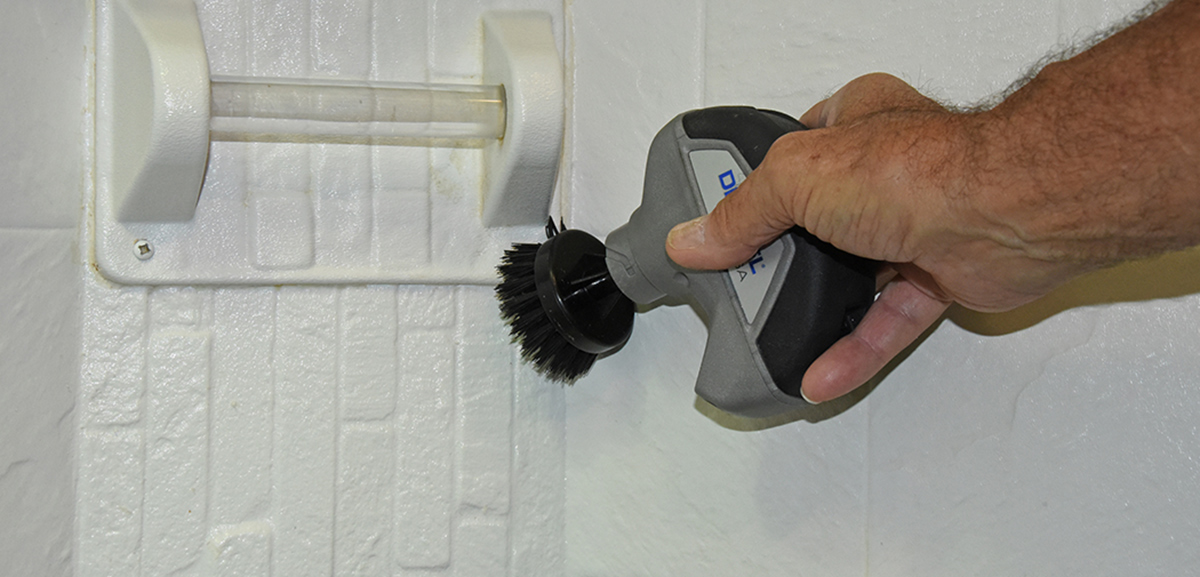
he term “scrubbing” is profanity in my personal dictionary, but a necessary evil for RVers. We spend time scrubbing barbecues, bathtubs, toilets, wheels — you get the picture. One of the best discoveries I’ve made is the Dremel Versa, a handheld, wireless cleaning device that makes easy work of removing grime and stains from various surfaces.
Dremel is no stranger to building tools that streamline repair and craft projects. I use the company’s quintessential rotary tool for all kinds of projects. The Versa is quickly becoming my favorite, although it’s hard to beat the Dremel rotary tool for making light repairs and getting into close quarters. The Versa fits ergonomically in your hand, is lightweight and can be fully charged in around two hours. It typically sells for about $55 on Amazon (https://amzn.to/3xCsiVw) and comes with an eraser pad, non-scratch pad, heavy-duty pad, bristle brush, rubber splash guard and the base for attaching the pads. Replacement pads are available in kit form or individually online and at home improvement stores.


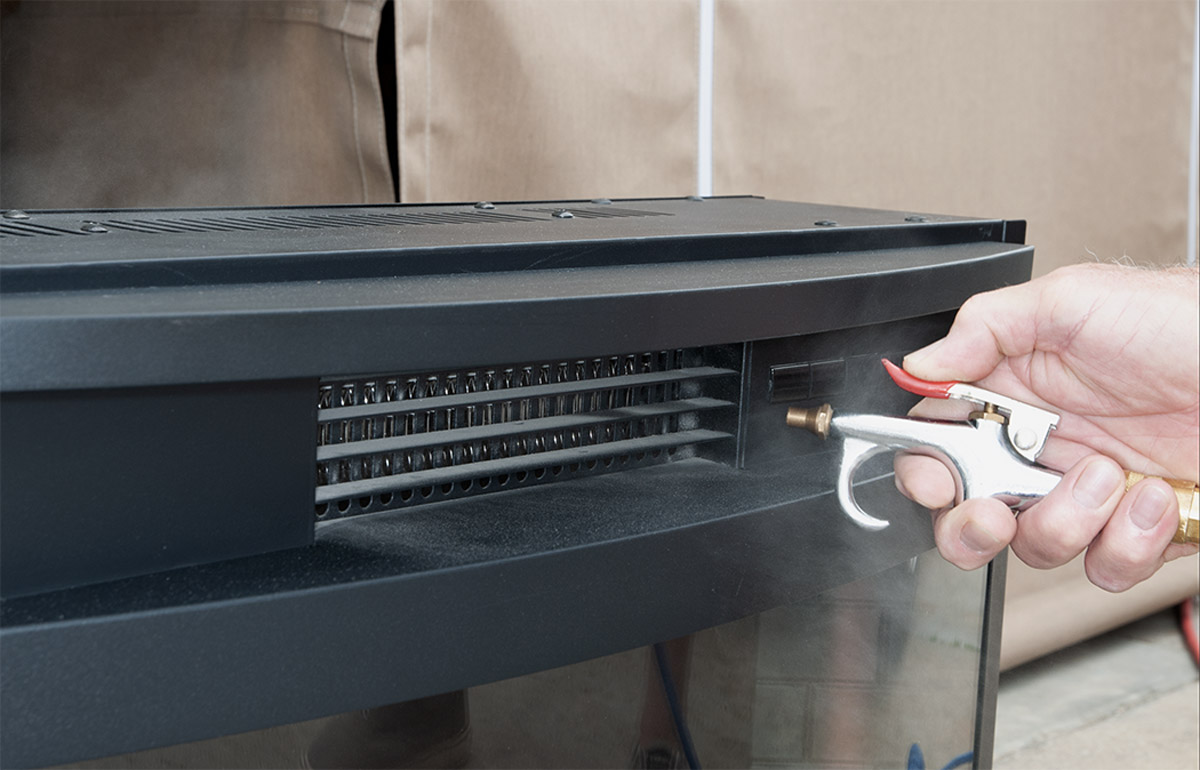
lectric fireplaces are common in RVs — not only do they provide ambiance, but the fan-driven heater feature eliminates the hassle of finding a suitable location for a portable space heater. It also allows owners to take advantage of electric hookups in RV parks rather than burning propane to power the furnace. And, well, there’s no denying the “homey” feel a fireplace can give an RV.
Rest assured that running the fireplace is safe, but like any heating device that forces warm air out of a register via a fan, it must be kept free of dust and lint to assure efficient operation. Fireplace maintenance is often overlooked because problems usually wane slowly and sometimes are not even noticed until it’s too late. Fortunately, the process is relatively simple — so cleaning once or twice a year should be in your active maintenance log.


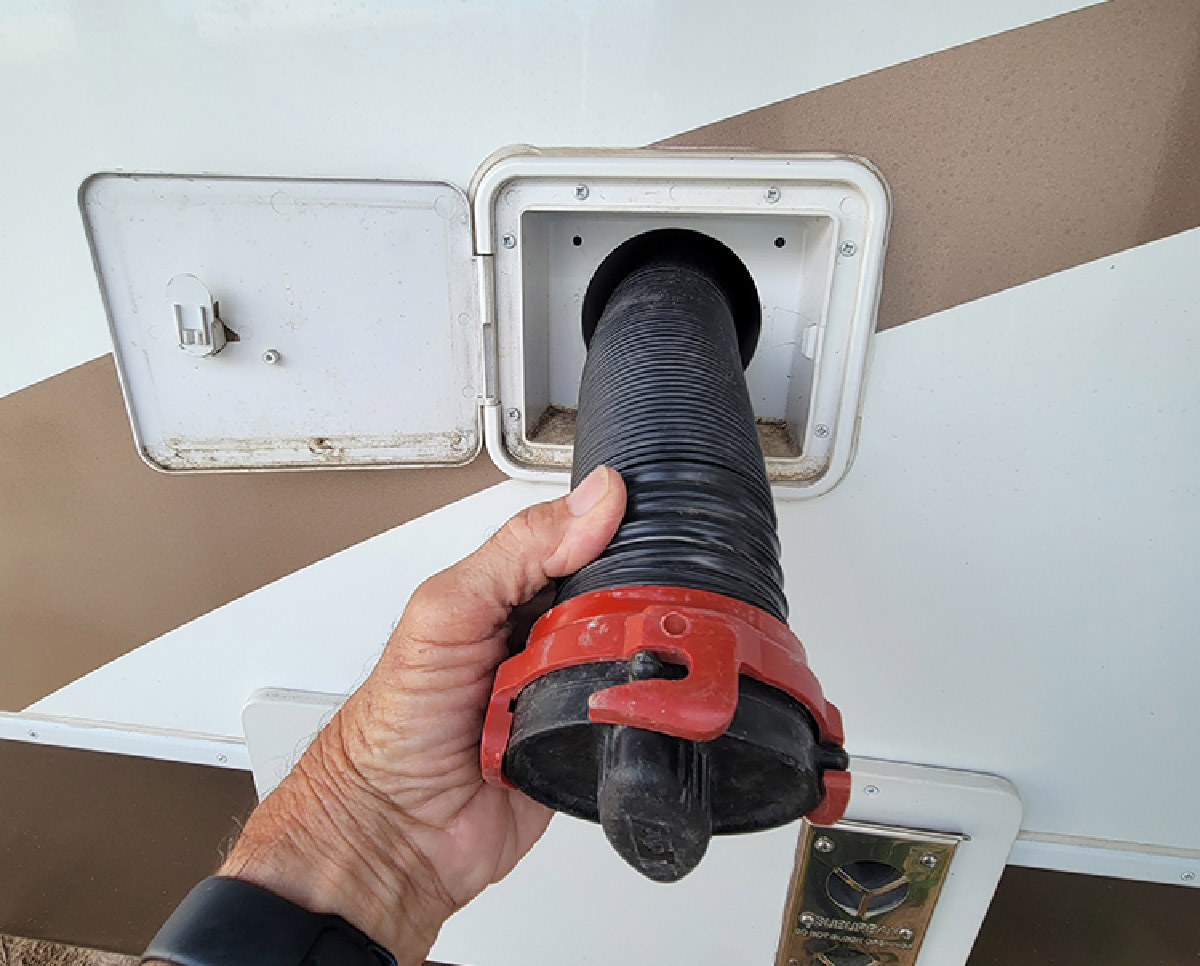
e all love RVing, but we can’t say that about dumping the holding tanks. A big part of the challenge is having the right sewer hose, suitable fittings and finding a place to store these hoses after they have been contaminated with waste from the tanks. There are literally dozens of sewer hoses available in heavy-duty and light-duty iterations, some with pre-installed fittings — not to mention the myriad fittings that can be installed on a blank sewer hose to fit your needs.
Trying to store one or more sewer hoses in tight quarters — like the bumper on the back of a trailer — can be maddening, however, especially if the fittings are too large to fit into the 4-inch square tube bumper so prevalent on RVs. A good solution is to buy a blank sewer hose and install your own fittings, customizing them to what works for you.


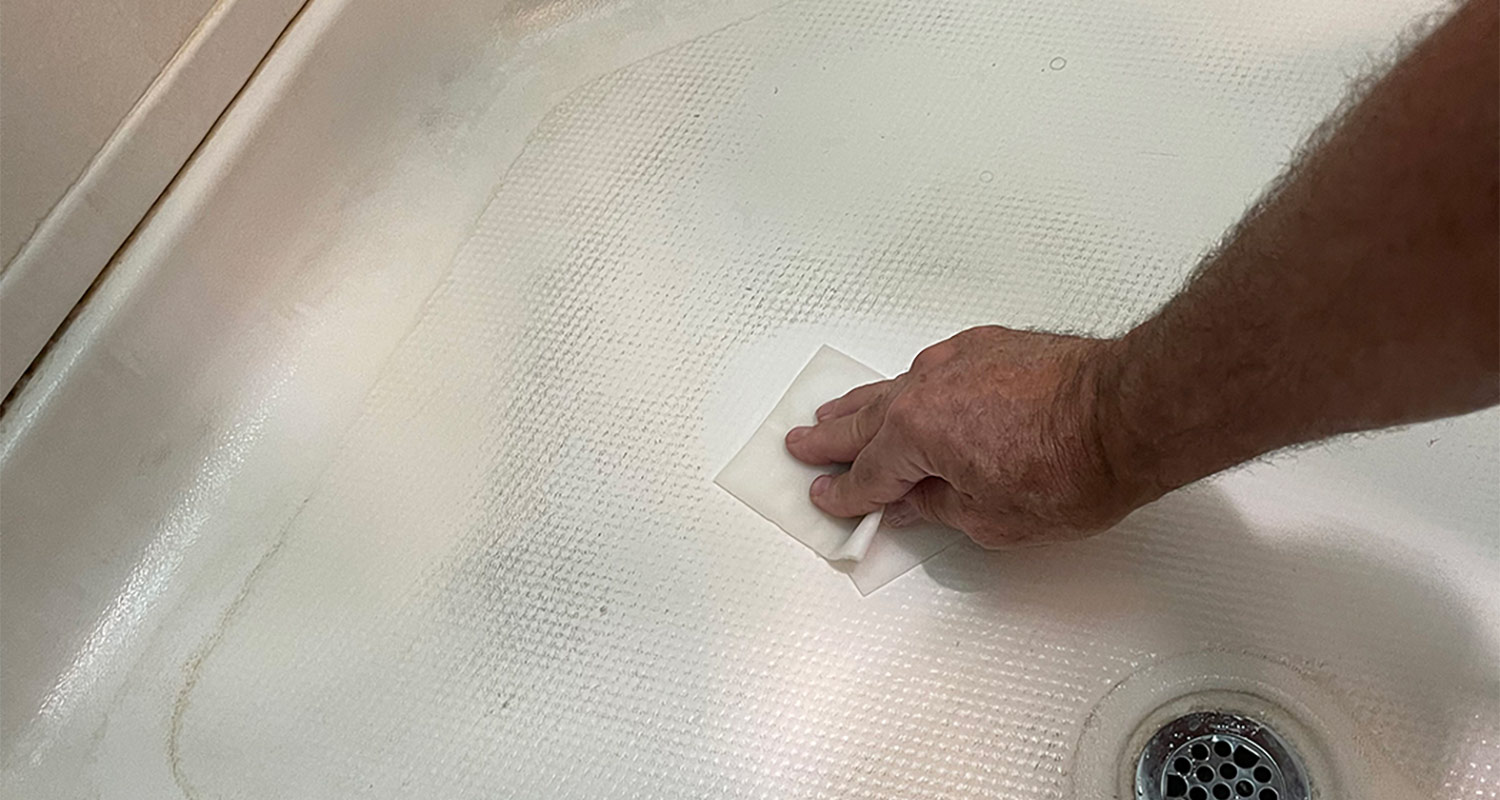
f you’re like most RVers, you have a large basket full of spray cleaners stored under the kitchen or bathroom sink. There’s nothing wrong with using spray cleaners; some work very well. However, an alternative we’ve used with a great deal of success is a Mr. Clean Magic Eraser. You know, the sponge-like product you probably saw in TV commercials that magically clean up stubborn stains and dirt. I wanted to try these cleaning pads for a long time, but a number of RV owners warned of possible scratching because of the abrasive make-up of the Magic Eraser.
I did some research, however, and discovered where it was safe to use these pads so I gave them a try — and the results were amazing. Granted, while there were no signs of damage, there are places where these pads should not be used: painted surfaces, wood, non-stick pans and stainless-steel, to name the most likely victims. According to the Mr. Clean information, it’s okay to use the Magic Eraser on porcelain (toilet), plastic and fiberglass (shower stall and bathroom sink).


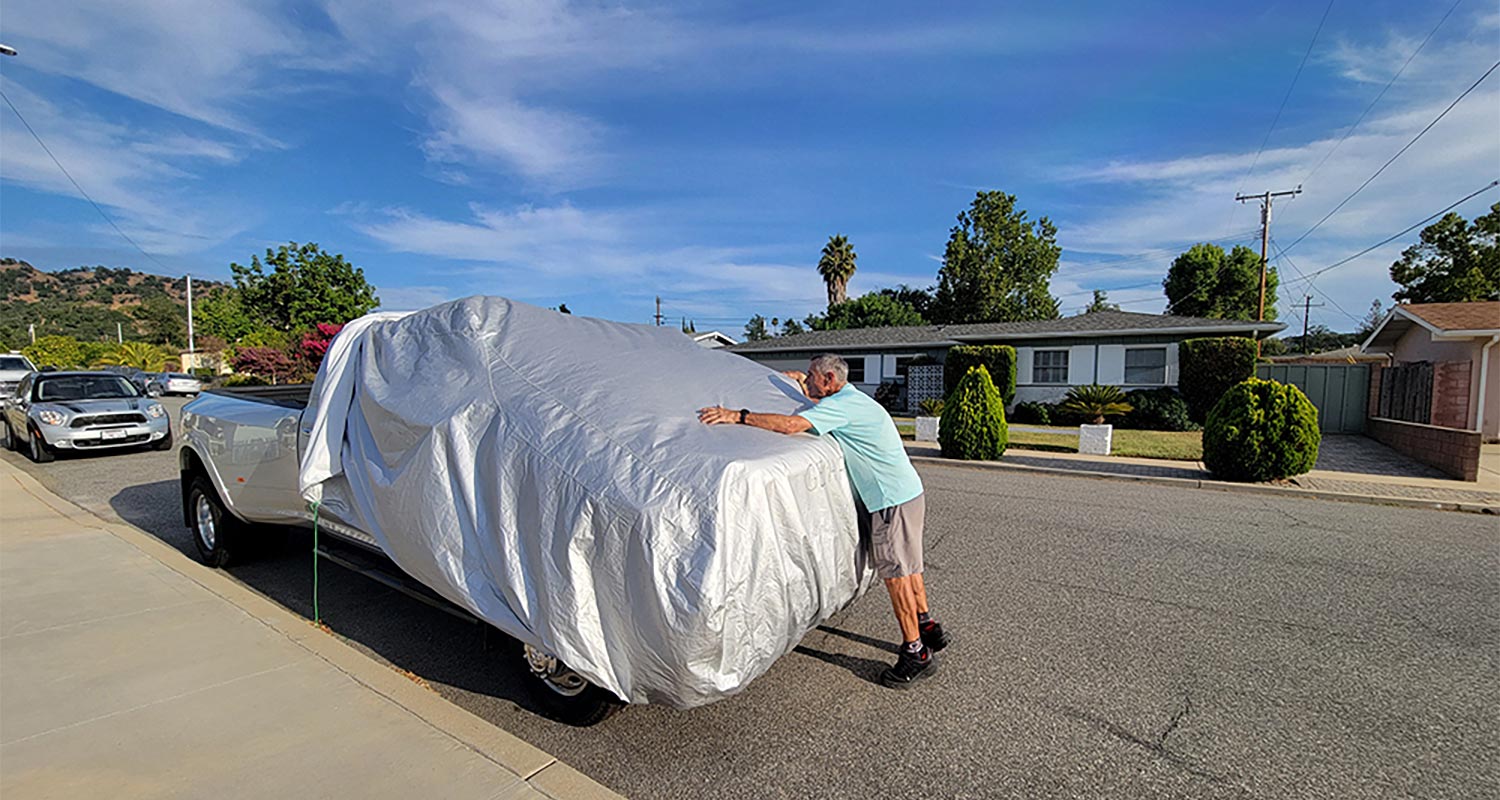
raveling to a new campground can be hard on your tow vehicle’s finish — and once you get there, well, not all campgrounds are clean, dust-free and void of trees. Those of us who are more fastidious don’t appreciate the mess trees and birds can make and certainly want to keep the dirt at bay. One way to prolong the washing of your tow or dinghy vehicle is to use a quality car cover.
Trying to cover a small car is usually painless but spreading the fabric over a large dually truck is another story. If you’re forced to cover the truck by yourself and have a good sense of humor, chasing a wayward cover can provide a bit of entertainment for anyone watching. By the time you get one end under control, the wind billows the fabric and it slides off while working on the other end. It’s almost a slapstick comedy show — and it’s even more entertaining if the paint is super-slick from waxing.


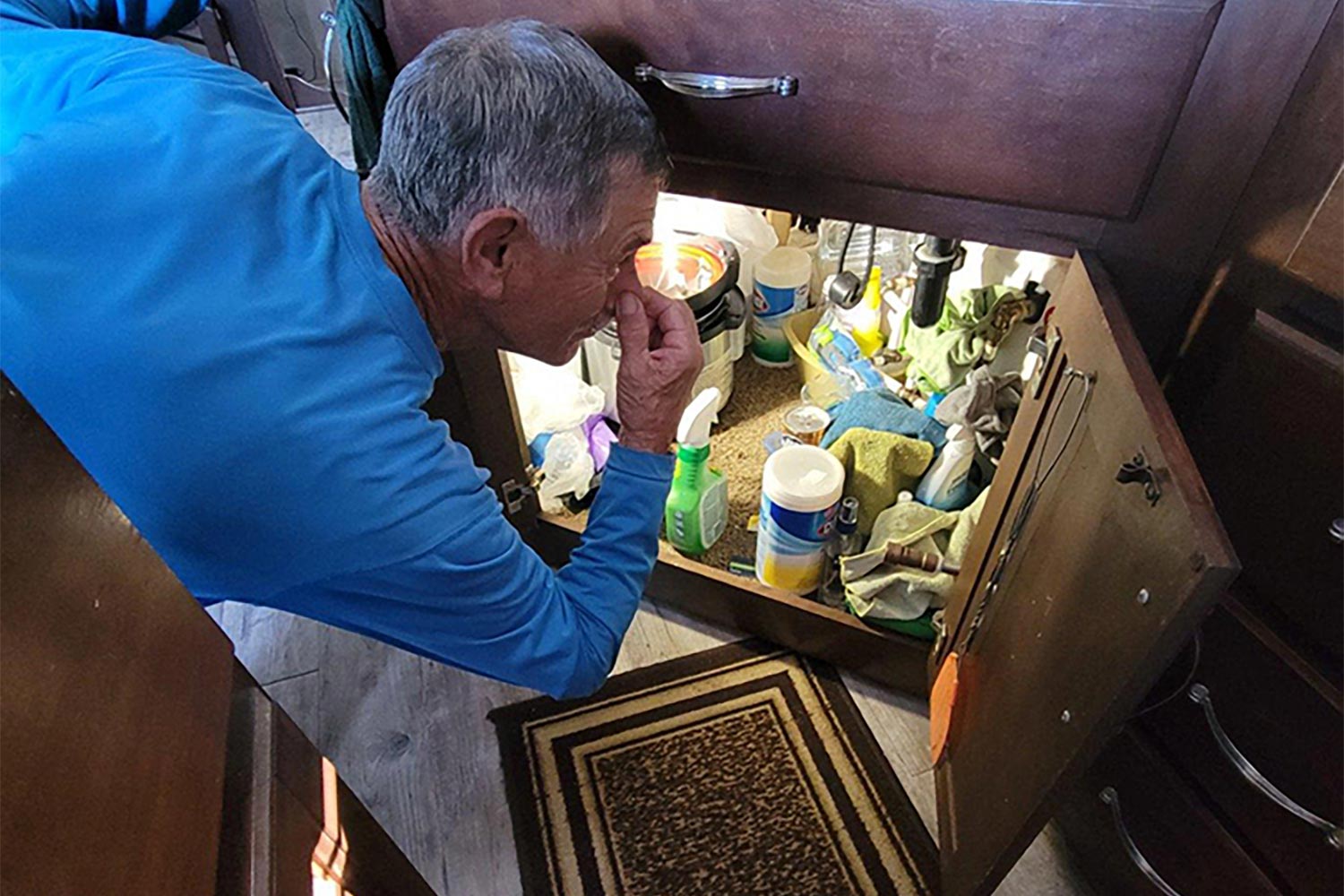
hen a friend called to tell me that, while boondocking at a nearby beach campground, he had a sewage smell under his galley sink and even after a thorough cleaning and tossing of unwanted supplies the obnoxious smell was still there, I knew immediately that he had a problem with the check vent under the sink.
Also called the vent valve or admittance valve, this often-ignored component is designed to vent the gray holding tank when it is physically impossible to run a vent pipe up through the roof. This is a common problem in bathroom sinks; most RVers mistakenly think this smell in the bathroom is coming from the black tank. It’s hard to believe that shower water and soapy water from doing dishes can smell this bad — but if you think about it, bacteria or even mold can develop in only a few days and, after a while, the smell can really fester as the mix of contents that are dumped into the gray tank remain stagnant. And, as my friend discovered, it’s a malady more noticeable when boondocking.


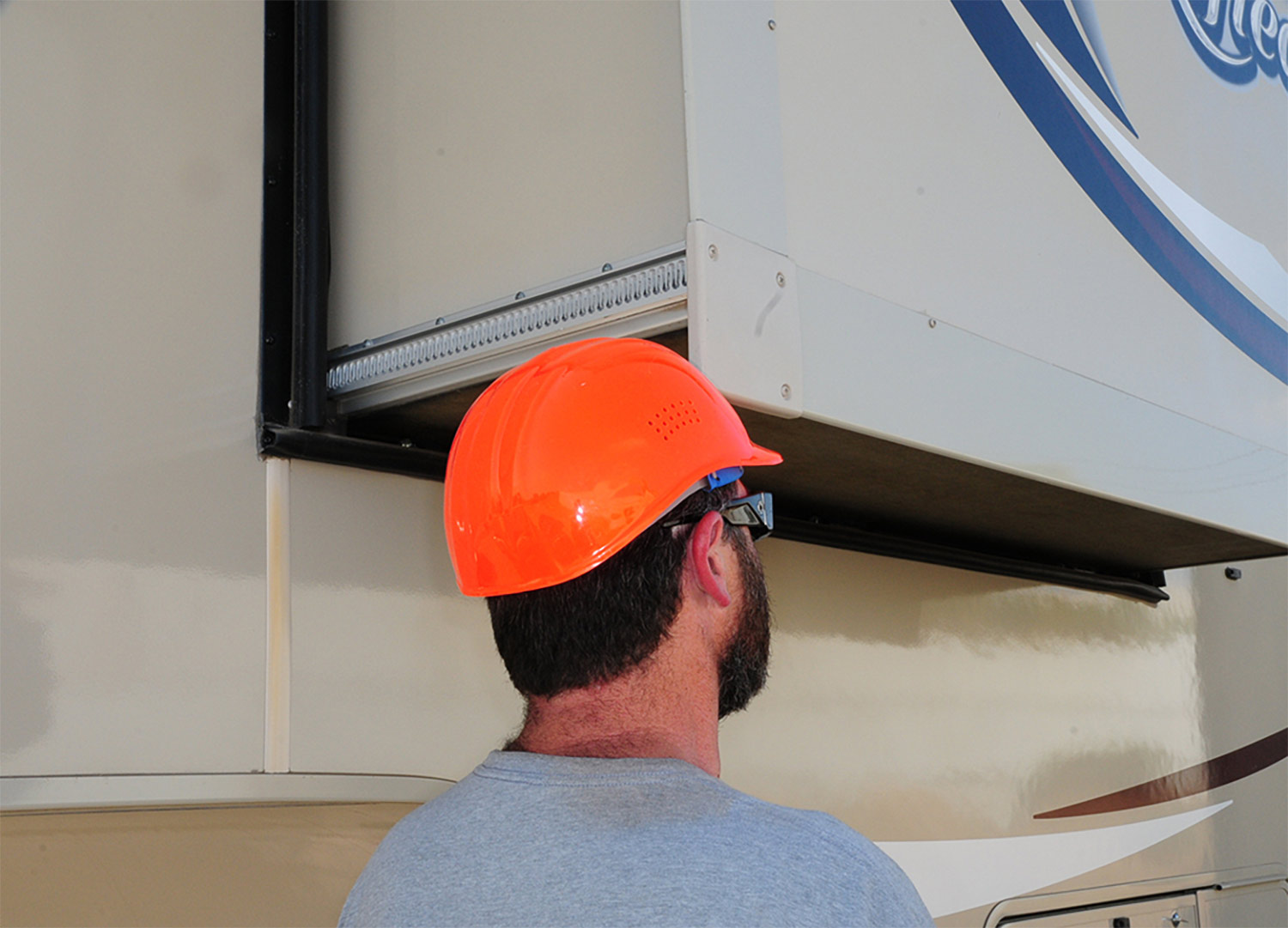
e all love our slideouts, but those corners can be troublesome for people who are too tall or when the room is too low to the ground. I hate to think we need to don hardhats, but I have managed to open my skull twice from crashing into slideout corners, which always win the battle. My altercations were with neighbors’ slideouts and each time the bill of my baseball cap prevented adequate vision to the offending impact point. After the second incident, I went to the Dollar Store — which, by the way, are no longer stocked with $1 items, courtesy of inflation that’s pushed things to $1.25 — and purchased swim noodles to help my friend cover the corners.
While swim noodles are fun to wrap round your body when floating in the pool, many RVers know they are also one of the most versatile items you can have around the RV. The most popular use for swim noodles is to attach them temporarily to the edges of the slideout corners. All you do is cut a noodle to length and slice it down the middle with a razor knife. Sections are then notched to allow the swim noodle to bend around the corner (which is really easy) — just make sure your hand is not in the way of the cut pathways; razor knives are not forgiving. Once the cuts are made, the swim noodle is pushed over the edges and friction will keep them in place unless it gets too windy, then your neighbors get the swim noodle(s) and you can retrieve it from them.


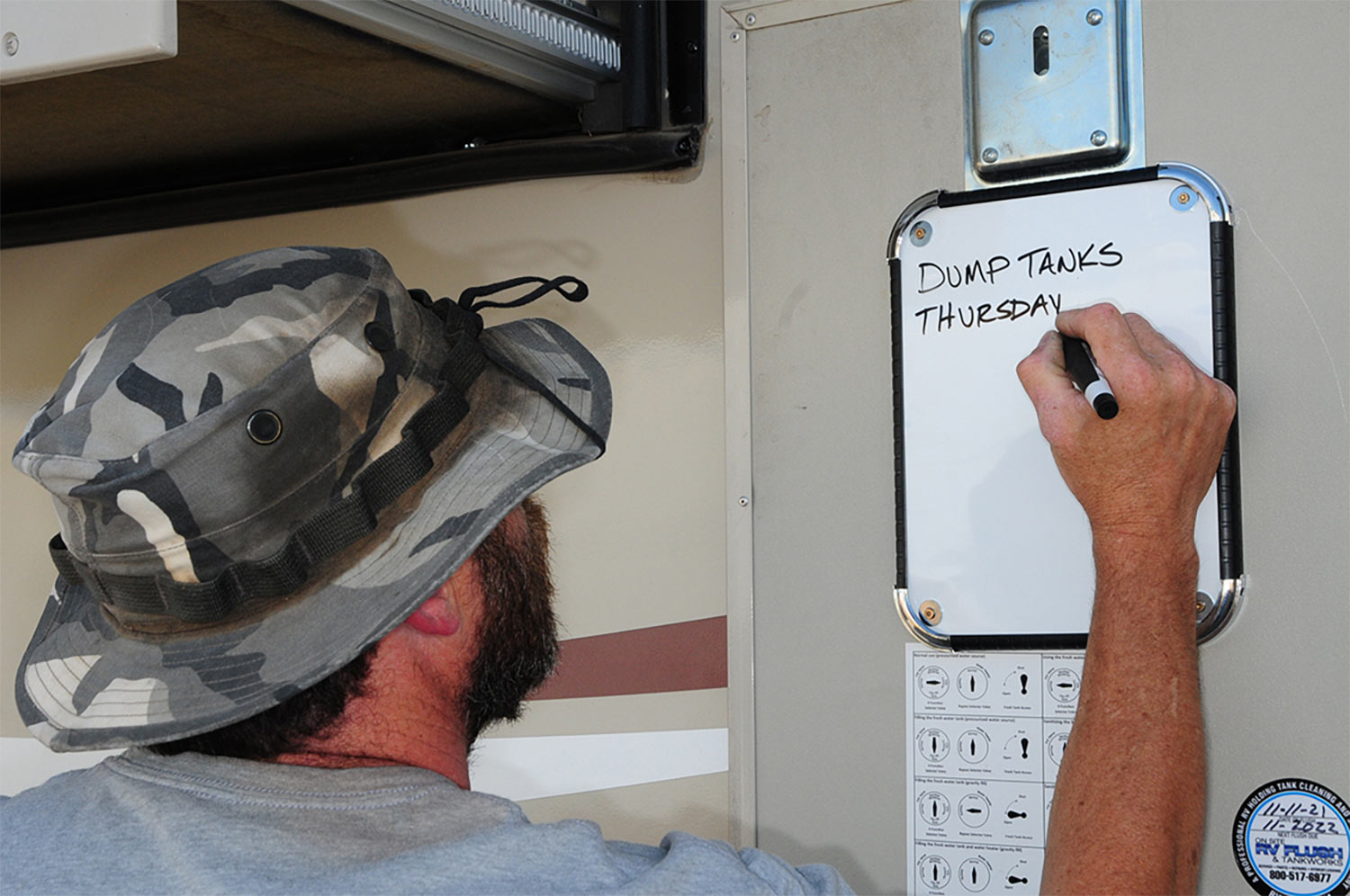
nless you have a photographic mind with endless memory space, you’re going to have to write a note occasionally. Some say it’s an age thing, but heck, every smartphone and tablet has a note-taking app, so forgetting must be a universal problem. It’s easy to dictate notes into your smartphone, but there are times when it’s simply not handy — and reaching for a piece of paper and a pencil/pen these days can be almost comical.
As an RVer, I like to keep track of when the holding tanks were dumped last since, as we all know, the monitors are practically useless. I also like keeping an RV “to-do” list and keep track of upcoming maintenance procedures. Rather than chasing a notebook, which seems to disappear frequently, I installed a white board on the inside of the storage compartment door nearest the utilities.



